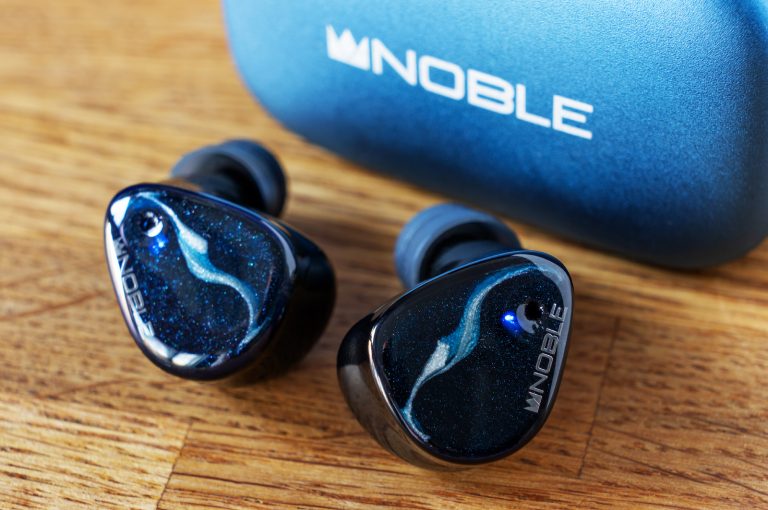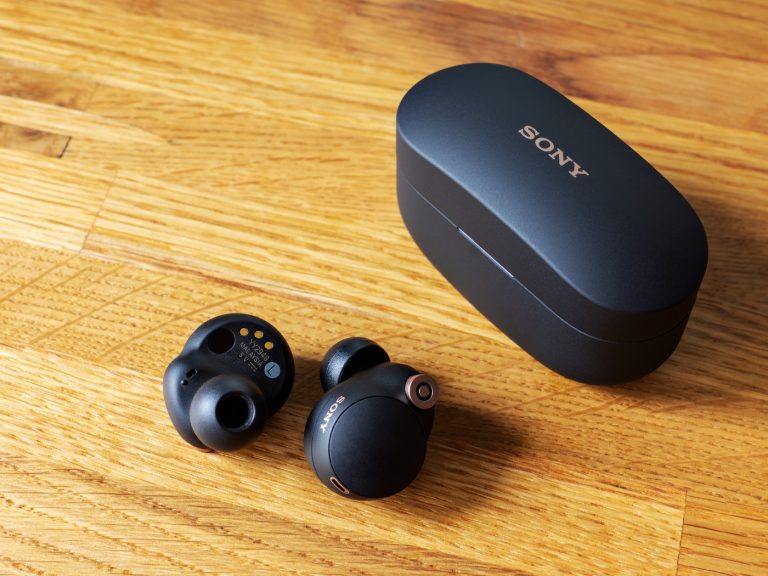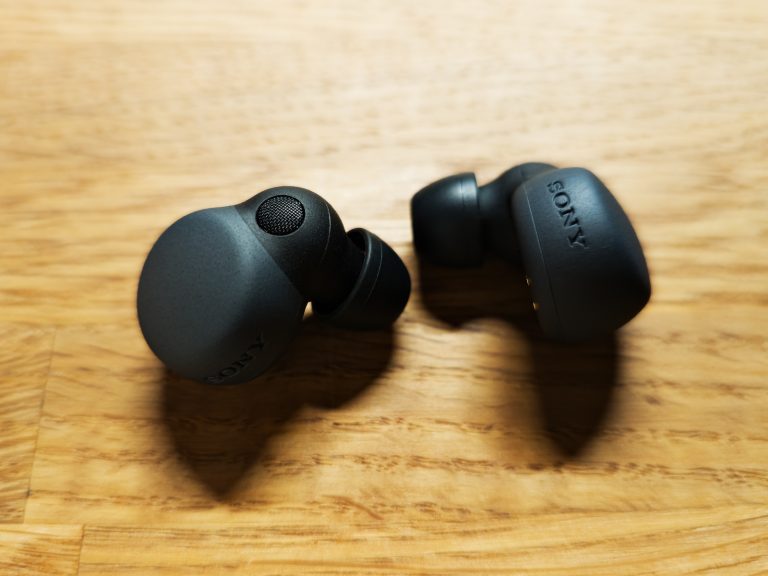Comparative Review of Current TWS Earphones Models
1. Introduction
Most TWS earphones sound disgusting. I stated this 5 years ago, and nothing has changed in these 5 years: everything ‘true wireless’ that came into my hands by accident (like, a colleague let me try it on) sounded very, very bad. However, there were always some people who would appear in the comments section with a take like “why are you messing with your wires when there are OK wireless models?”
Therefore, I decided to make a comprehensive comparative review based on a simple approach:
- We buy the best (the most expensive of the older lines) current models from popular manufacturers;
- We measure them, listen to music in them, and test their smart functions.
So said, so done! Though it wasn’t done quickly.
Are there any decent models on the market right now? Is it right time to switch from wires to TWS? Is it possible not to lose in ‘sound quality’? What should we choose, after all? These are all the questions I’ll try to answer. I bought all the earphones included in the review with my own money.

2. Some of the finer points of TWS earphone measurements
In-ears are usually measured so that the second resonance is at 8 kHz, which corresponds to the length of the auditory canal of 30 mm. If anyone is interested in formulas, I’ve given them here. A driver of a TWS earphone, designed as an earbud with a ‘stick’, is located significantly further from the eardrum, compared to drivers of in-ear models. Therefore, measurements must be made so that the resonance is shifted closer to 7 kHz. The specific frequency will depend on the model of earphones and the structure of the user’s ears, but there will always be some shift.
How much does this affect the measurements? In some cases, it does, radically.
You usually see graphs like this, with a 8 kHz resonance, when it comes to TWS:
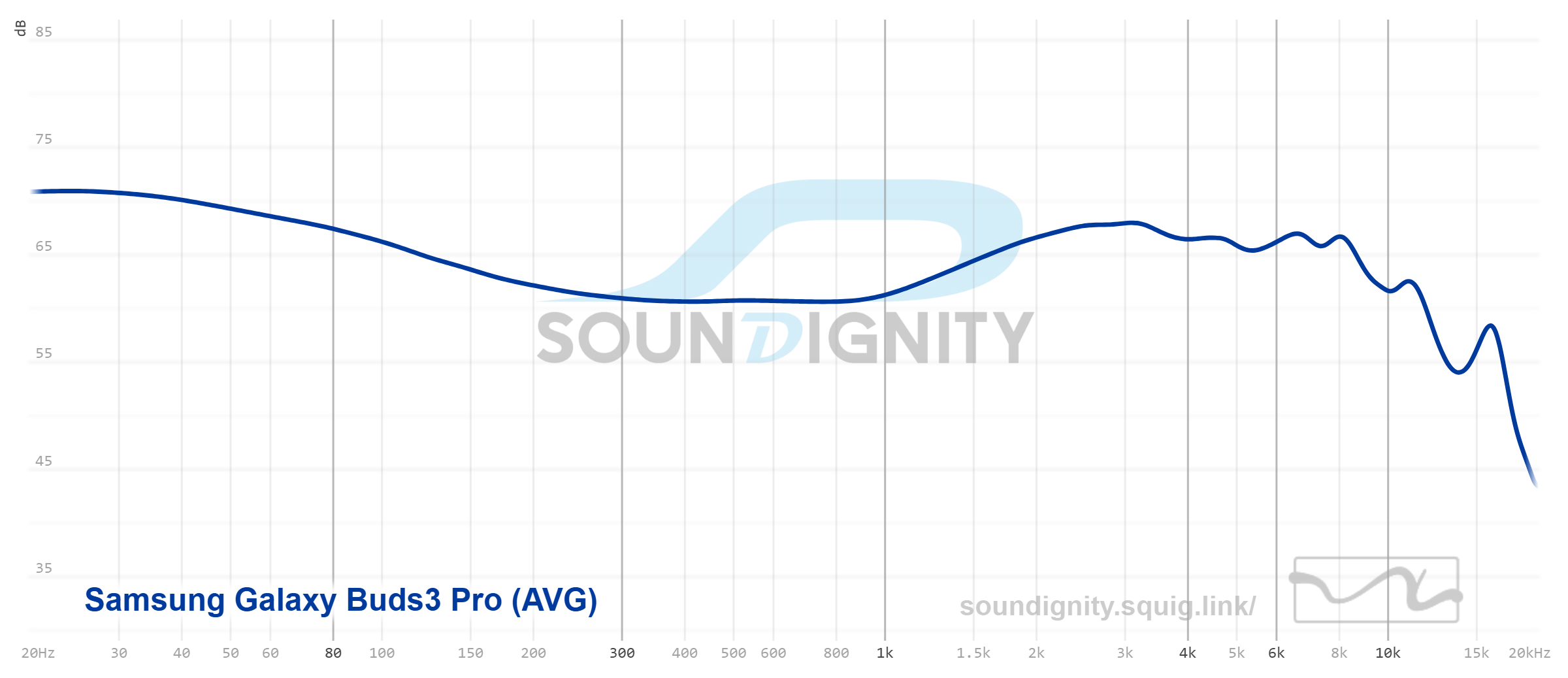
In fact, this graph should look like this if you shift the resonance to 7.6 kHz where it should be:
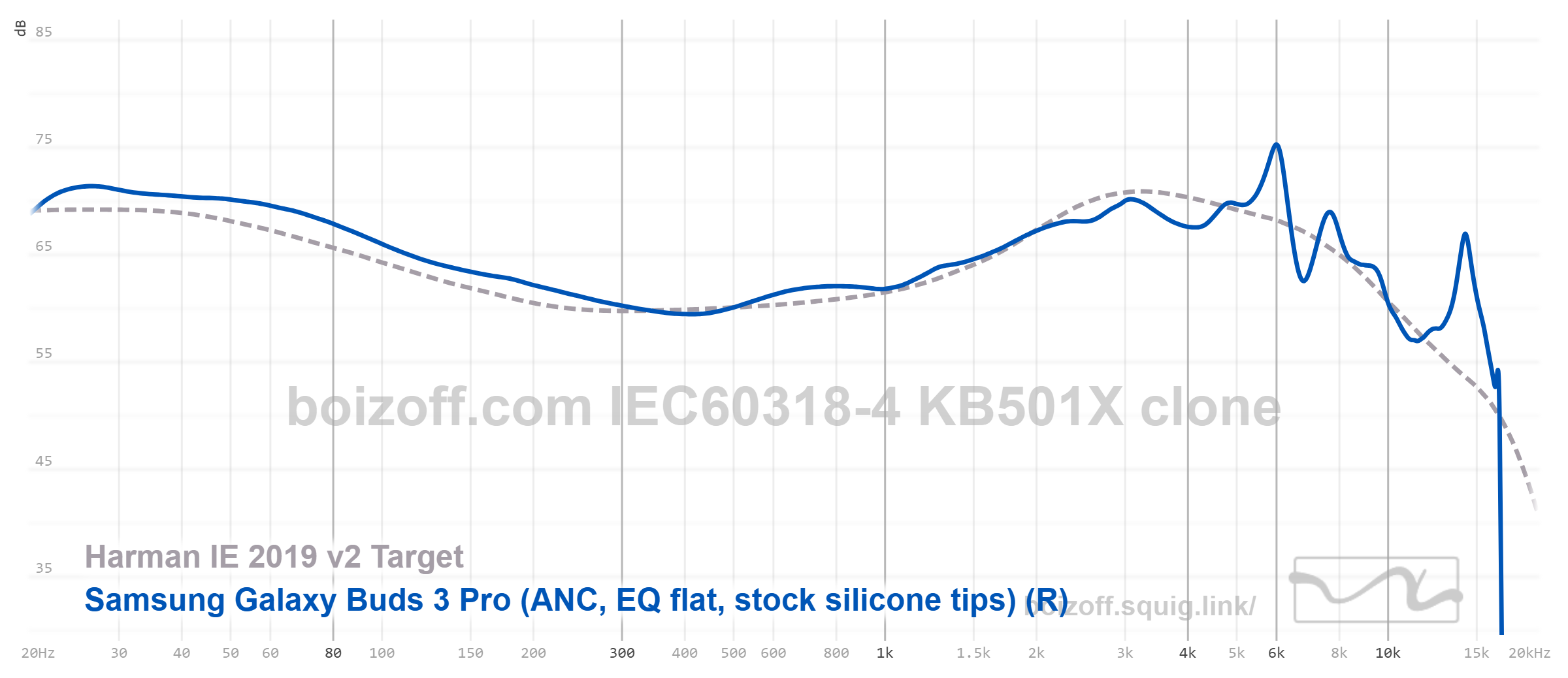
This is due to the fact that when the fit depth changes, not only the location of the second resonance peak, but also the entire frequency response segment from 3 kHz and above changes, too. But it is difficult to measure TWS: eartips of almost all wireless models are oval in shape, they’re fixed on the rig poorly, but, most importantly, they shouldn’t be placed inside the coupler (like in-ear models), but carefully pressed against its orifice or inserted into a rubber ear. One last point, another problem of ‘deceiving’ the earphone sensors needs to be solved somehow so that when they are on the measuring rig, the earphones carry on ‘thinking’ that they are inserted into ears and do not turn ANC off.
In short, measuring TWS correctly is a technically difficult, physically troubling, and extremely time-consuming task that requires non-obvious moves such as using Blu Tack, setting putty and other improvised means. That’s why 90% of TWS measurements on squig.link are incorrect. They don’t reflect the real sound of the models or just don’t exist for a number of wireless earphones because everyone can’t be bothered.
If you wondered why this review took so long, the answer is above.
3. Selection of models
What models did I choose? The latest ones in terms of release time, the most expensive models from well-known manufacturers who deal with all sorts of smart devices. ‘Top popular’, as schoolkids say. These earphones are actively sold in stores, ant they are bought especially because they are of the same brand as users’ smartphones:
- Huawei FreeBuds Pro 4
- Nothing Ear (3) 2024
- OnePlus Buds Pro 3
- Realme Buds Air 7 Pro
- Samsung Galaxy Buds3 Pro
- Sony WF-1000xm6
- Soundcore Liberty 4 Pro
- Vivo TWS 4
- Xiaomi Buds 5 Pro
Here are models from manufacturers who supposedly should know what’s what when it comes to sound, and they have been releasing TWS for some time now:
- Bose QuietComfort Ultra Earbuds
- JBL Live Beam 3
- Sennheiser Momentum 4 True Wireless
The cheapest TWS with ANC that are currently in the market are:
- Moondrop SpaceTravel 2
And these just came to hand when I was working on this article:
- Soundpeats Air5 Pro
In total, there are 14 popular models, the people with which I see every day on my way to work and home in the subway, on the street, and in the office.
4. What models are not here? What aspects do I consider not important?
What’s missing:
- Bose QuietComfort Ultra Earbuds (2nd Gen) are not yet available in Russia.
- Nothing Ear (2025), for the same reason.
- Sony WF-1000xm4 and Sony Linkbuds S are discontinued.
- Earphones by Creative, Marshall, Noble, Devialet, Bang & Olufsen, Bowers & Wilkins, Klipsch, Audio-Technica, Denon, JVC, Technics, etc. I grudge the money on them, given that the result is 90 percent likely to be bad.
- Earphones by little-known Chinese companies, for the same reason.
- Apple earphones. I have an Android phone, and I’m not interested in the products of this company because it only works fully with Apple phones.
I do not consider the following issues on purpose:
- Design. I believe that the readers of my blog are mature enough to do without my assessment in that line.
- Sound of equalizer presets. I’m not interested in them because I have a measuring rig. If the sound can be made better, I will provide the tuning in the form of a picture or numbers directly in the name of the measurement on squig.link.
- Battery life. It matters, but not really: no model can stand a full-time working day. But, most importantly, you won’t stand the whole day wearing earphones either. Therefore, you will still put them in a case where they will charge very quickly – all modern models can do this. And all modern TWS can stand, well, from 3 to 5 days, in this mode of opportunity charging from the case if we talk about fresh batteries. And it can be argued with exactly the same level of generality that the batteries will be degrading, the battery life will be decreasing, and the application will be showing different charge levels in the left and right earphones (if it can do it) – that’s how it works for everyone. That’s why my advice is simple: just forget about this characteristic because any of today’s TWS earphones work for about the same amount of time in real usage scenarios.
- IPX rating. My practice shows that you can’t swim in any model, but you can sweat a lot in any model, even if it doesn’t have this rating at all.
- Sound with ANC turned off. You are not buying ANC headphones to avoid using it.
- Wireless charging. In 99% of cases, it is not a determining factor when making a purchase decision.
5. Evaluation criteria
We’re talking about TWS earphones, which are essentially ‘smart’ hardware and software suites. Their main purpose is to provide especially comfortable playback of musical content, as well as telephone conversations in an urban environment.
Consequently, TWS earphones should:
- Sound good with active noise reduction enabled.
- Provide active noise reduction.
- Have a clear and tunable control, and this criterion also applies to the purely physical parameters of the earphones.
- Decently transmit the user’s speech during voice calls, including when there is strong external noise.
- Clearly and realistically convey the sounds of the environment in the acoustic transparency mode.
- Have a stable and well-organized proprietary application.
- Have extensive audio equalization capabilities via the proprietary application. Parametric equalization is better.
- Have a basic set of intelligent functions that eliminate the need for manual control of earphones. I consider the most important of them to be:
- Automatic interruption of music playback when the earphones are removed from the ears, as well as automatic resume when the earphones are placed back in the ears. This is a must-have.
- Automatic activation of acoustic transparency and interruption of music playback during voice call initialization. This is a must-have, too.
- Automatic activation of acoustic transparency and interruption of music playback when making sounds with your mouth, so to speak. I’ll use Sony’s ‘talk-to-hear’ term below. Moreover, speech should be distinguished from coughing and smacking. This is from the category of highly desired.
In other words, TWS earphones should work well both as earphones and as a headset, and the implicit logic of their operation should almost completely free you from having to touch them with your hands after you’ve put the earphones in your ears.
Based on such requirements, I do not consider functions such as ‘immersive sound’, rain sound generation, as well as the use of an earphone case as a flashlight (yes, that does happen sometimes, too) to be anyhow significant.
Last, but not least is the prices: I took the minimum prices for new earphones, which were current as of September 2025, from marketplaces / trading platforms.
Let’s start!
6. Nothing Ear (2024)
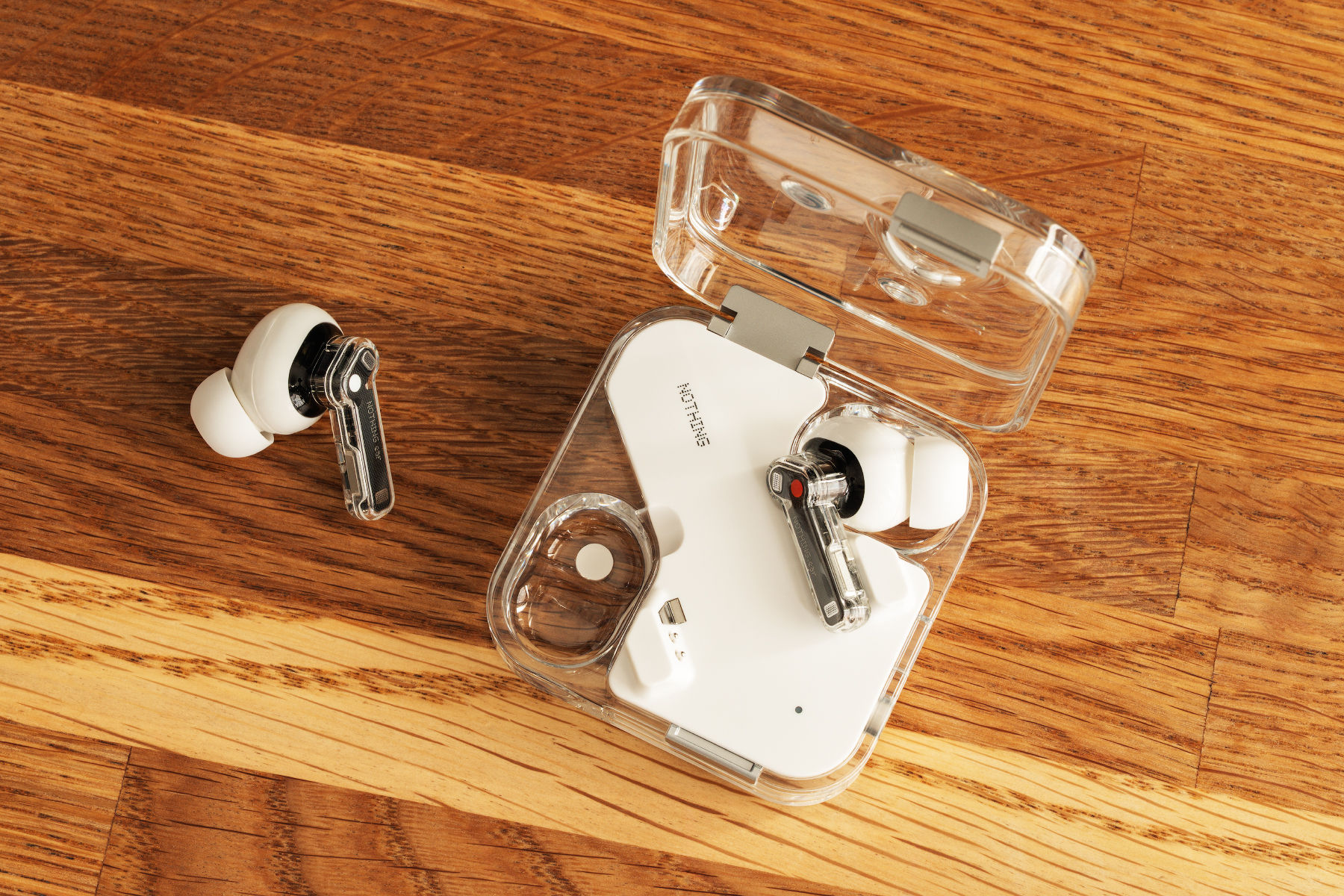
Price: $80
Specifications and features:
- Firmware version as of the review date: 1.0.1.54
- Bluetooth version: 5.3
- Codecs: AAC, SBC, LDAC, LHDC
- Controls: press
- Equalizer: simplified or parametric (with limitations)
- Connection to two devices: yes
- Auto-pause when removing the earphones: yes
- Talk-to-hear: no
- Beginning of a phone conversation: the ANC mode does not change, music playback stops automatically
- Eartips: oval with proprietary mounts
- Extra: an ability to exchange parametric equalizer tunings via QR codes
- Gray area: the application does not display the case charge
- Active noise reduction: 3/5
- Transparency mode: 2/5
Sound and measurements:
Ear (3)’s frequency response without the equalizer use:

Is there an equalizer here? Oh yes, and even a parametric one. But it’s implemented with some limitations. The frequency for each point can only be set within certain limits: 20-99 Hz for the first one, 100-199 Hz for the second one, etc. (this approach was continued in Nothing Headphone (1)). Therefore, you won’t be able to use the automatic squig.link equalization, so you’ll have to pick out the frequency, Q factor, and gain manually.
That’s what I picked out:

This tuning provides a sound that’s very close to IEF Preference 2025, and I consider it most suitable for outdoor use of headphones:
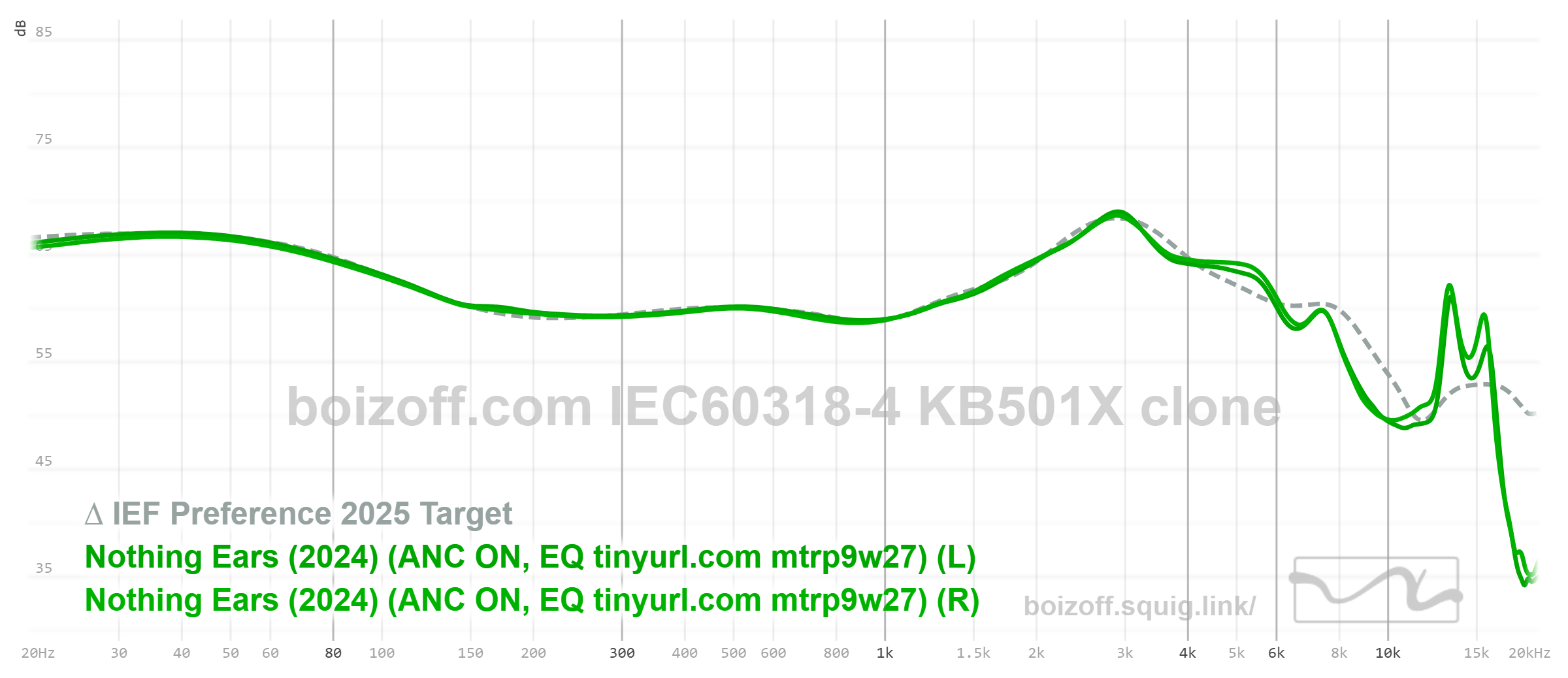
With this tuning, Ear (2024) sound so good that I’m ready to recognize them as the best TWS in terms of sound at the moment. I really want to get to know Ear (2025), yes.
Usage experience:
The earphones work stably and predictably. It seemed to me that the response to pressing had not always been clear, and sometimes the controlling presses were not registered, but I may be mistaken. The noise reduction is mediocre, as are the microphones. In the acoustic transparency mode, the environment is heard not very well, kind of muffled. But, on the bright side, there is a parametric equalizer in the proprietary app (along with the simplified version), a separate bass control, a third–party web application for settings control, an easy-to-clean case, and a striking design. And the exchange of equalizer presets through pictures as a killer feature, of course.
Poor but clean! And the sound after equalization is really outstanding.
7. Xiaomi Buds 5 Pro
Price: $205
Specifications and features:
- Firmware version as of the review date: 3.3.5.2
- Bluetooth version: 5.4
- Codecs: SBC, AAC, aptX Lossless/Adaptive
- Controls: press and slide
- Equalizer: 8-band
- Connection to two devices: yes
- Auto-pause when removing the earphones: yes
- Talk-to-hear: no
- Beginning of a phone conversation: the ANC mode does not change, music playback stops automatically
- Eartips: oval with proprietary mounts
- Extra: an ability to record conversations by means of the earphones themselves
- Gray area: the application does not display the case charge
- Active noise reduction: 3/5
- Transparency mode: 3/5
Sound and measurements:
Two key profiles of the Buds 5 Pro equalizer are Harman Master and Harman AudioEFX:
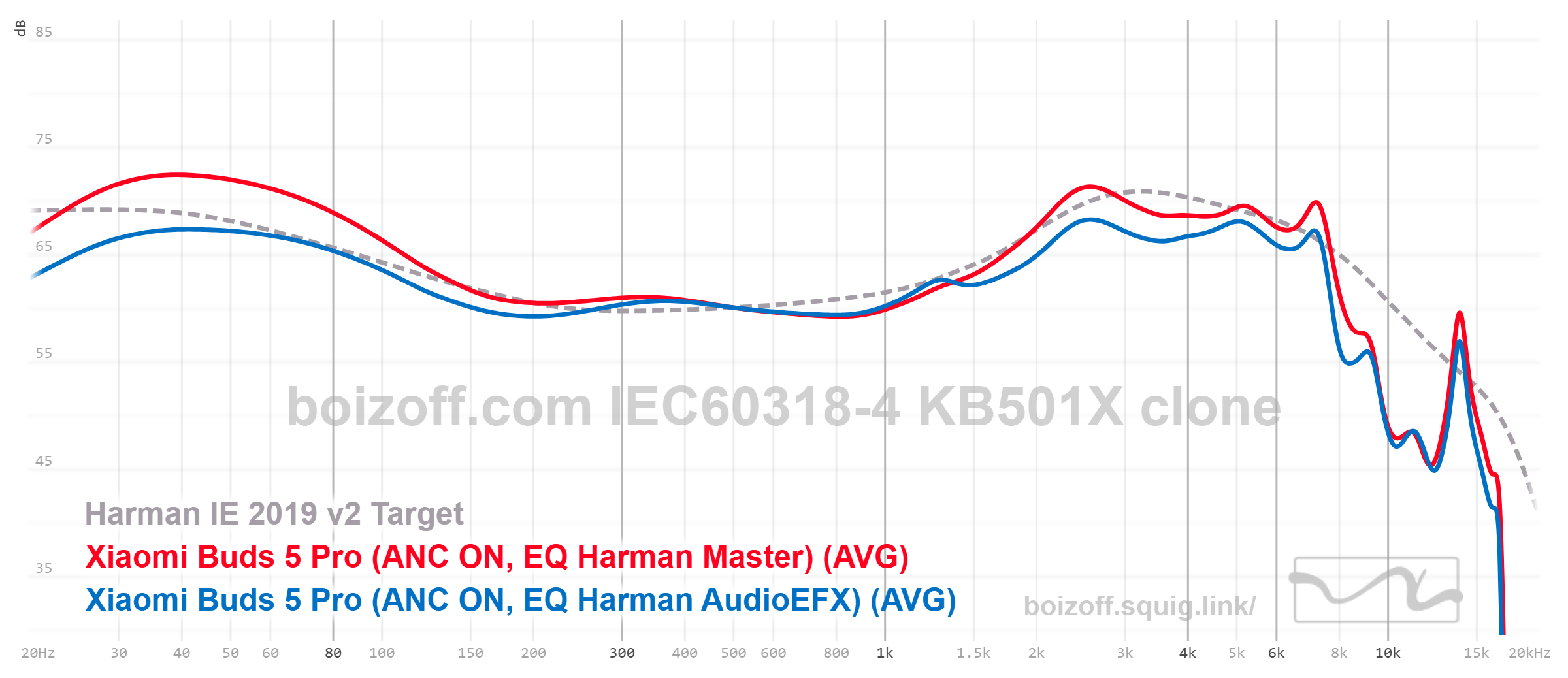
They called it Harman, they aimed at the Harman target curve, and, in general, they quite hit it. Harman Master mumbles a bit because they overdid the subbass, whereas Harman AudioEFX, on the contrary, sounds a little too bright. But, all things considered, this is a more or less Harman tuning, which can be slightly adjusted with the built-in 8-band equalizer to your liking.
That is, the sound is more than acceptable right out of the box, but there is a caveat: when active noise reduction is turned on, the middle and upper frequencies sometimes start ‘walking’ from the left ear to the right one or vice versa and then return to normal, or, in other words, the volume balance, namely the midrange part, between the left and right earphones suddenly begins to shift to the left or right. The effect usually appears at the beginning of listening (or in the first minutes after you take the earphones out of the case), as well as near noisy objects, construction sites, highways, etc. It doesn’t last long, just a couple of seconds, and it doesn’t happen often, but it’s a little annoying.
I’ll note that you can enable auto-correction of frequency response and volume depending on external noise in the app, and this has a very positive effect on the sound.
Usage experience:
Stable connectivity, adequate response to control gestures, active noise reduction implemented quite well, a well-designed application — Buds 5 Pro are equipped with all the fixings. The earphones fit comfortably in the case, there is no need to aim there, and the case itself is designed in a way that it is convenient to clean. The microphones are mediocre. There have been no surprises in usual usage scenarios, and even the shape of the enclosures turned out to be more fitting for me than most models in this comparative review.
Smart functions… there are no smart functions. But there is an autopause! Let’s be grateful at least for that. However, the fact that the application (for the earphones of their price!) does not display the case charge is an outrage indeed. On the upside, the connection is quite stable.
The elder brother of this model, Xiaomi Buds 5 Pro WiFi, is able to connect to a smartphone via WiFi Direct, that is, via a ‘thick’ wireless channel, through which the sound will safely get without compression. But it only works with some smartphones from the same manufacturer, and it’s not really clear why, because the main problem with TWS earphones is not sound compression, but tuning.
This is one of the most decently sounding without additional tuning, but also most expensive models among those mentioned in this review.
8. OnePlus Buds Pro 3
Price: $95
Specifications and features:
- Firmware version as of the review date: 143.143.039
- Bluetooth version: 5.4
- Codecs: SBC, AAC, LHDC
- Controls: press and slide
- Equalizer: 6-band
- Connection to two devices: yes
- Auto-pause when removing the earphones: yes
- Talk-to-hear: no
- Beginning of a phone conversation: the ANC mode does not change, music playback stops automatically
- Eartips: oval with proprietary mounts
- Extra: nothing defining
- Gray area: none
- Active noise reduction: 3/5
- Transparency mode: 3/5
Sound and measurements:
Here is the standard sound profile and the result of equalization to the Harman curve:
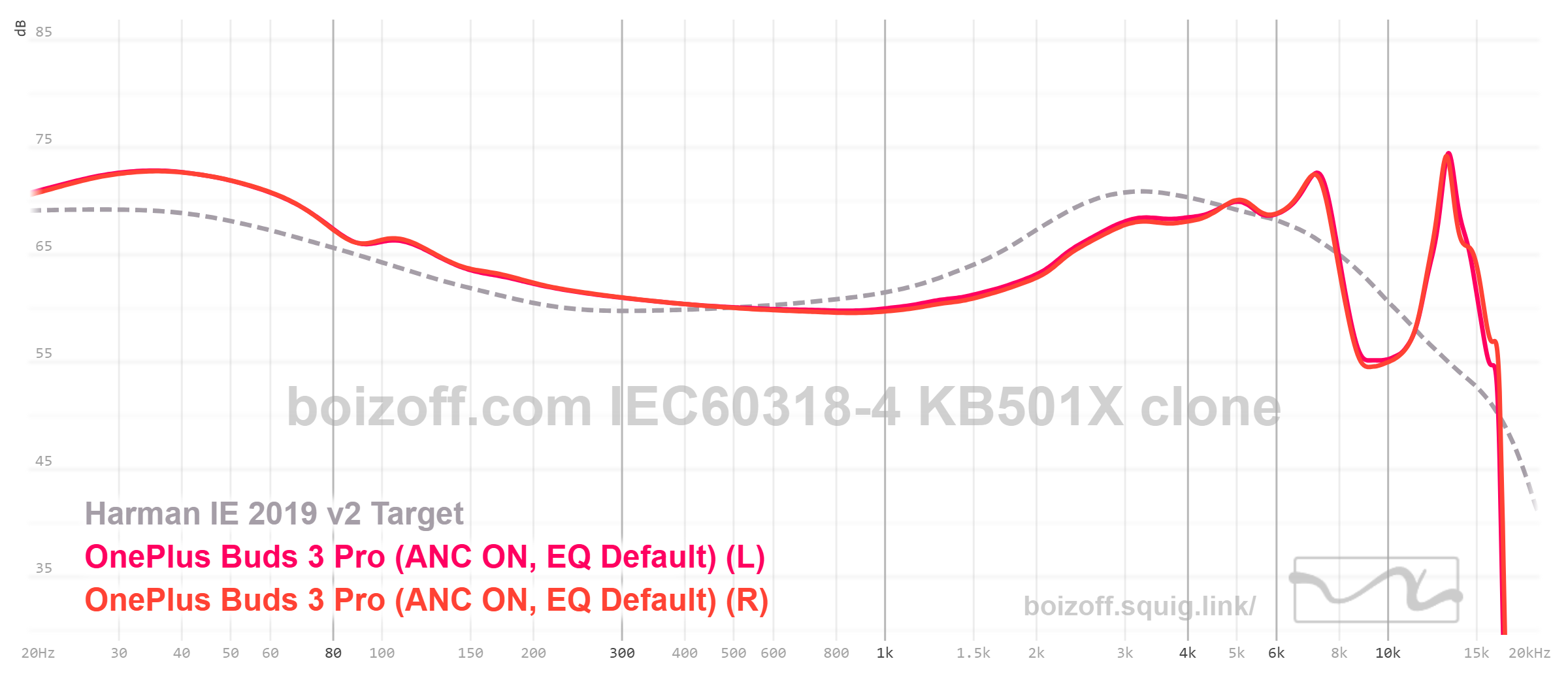
The sound delivery is disgusting, pseudo-detailed, with a raised subbass, underperformance at the first resonance (3 kHz), and peaks at 7 and 13 kHz. Any tracks interpreted by Buds Pro 3 have an annoying hissing side sound. While it’s still somehow palatable at low volume, then at high volume, in my understanding, the sound becomes physically unpleasant. The standard 6-band equalizer can improve the situation, but not completely fix it.
Usage experience:
Buds Pro 3 work more or less stably and predictably. They have no smart functions but the auto-pause. Microphones are copy-book.
These are ‘ordinary TWS earphones’ with a nasty sound that don’t stand out from competitors, and that’s it.
9. realme Buds Air 7 Pro
Price: $67
Specifications and features:
- Firmware version as of the review date: 1.1.0.83
- Bluetooth version: 5.4
- Codecs: SBC, AAC, LHDC
- Controls: touch
- Equalizer: 6-band
- Connection to two devices: yes
- Auto-pause when removing the earphones: yes
- Talk-to-hear: no
- Beginning of a phone conversation: the ANC mode does not change, music playback stops automatically
- Eartips: oval with proprietary mounts
- Extra: nothing defining
- Gray area: none
- Active noise reduction: 3/5
- Transparency mode: 3/5
Sound and measurements:
Frequency response when using a flat equalizer profile:
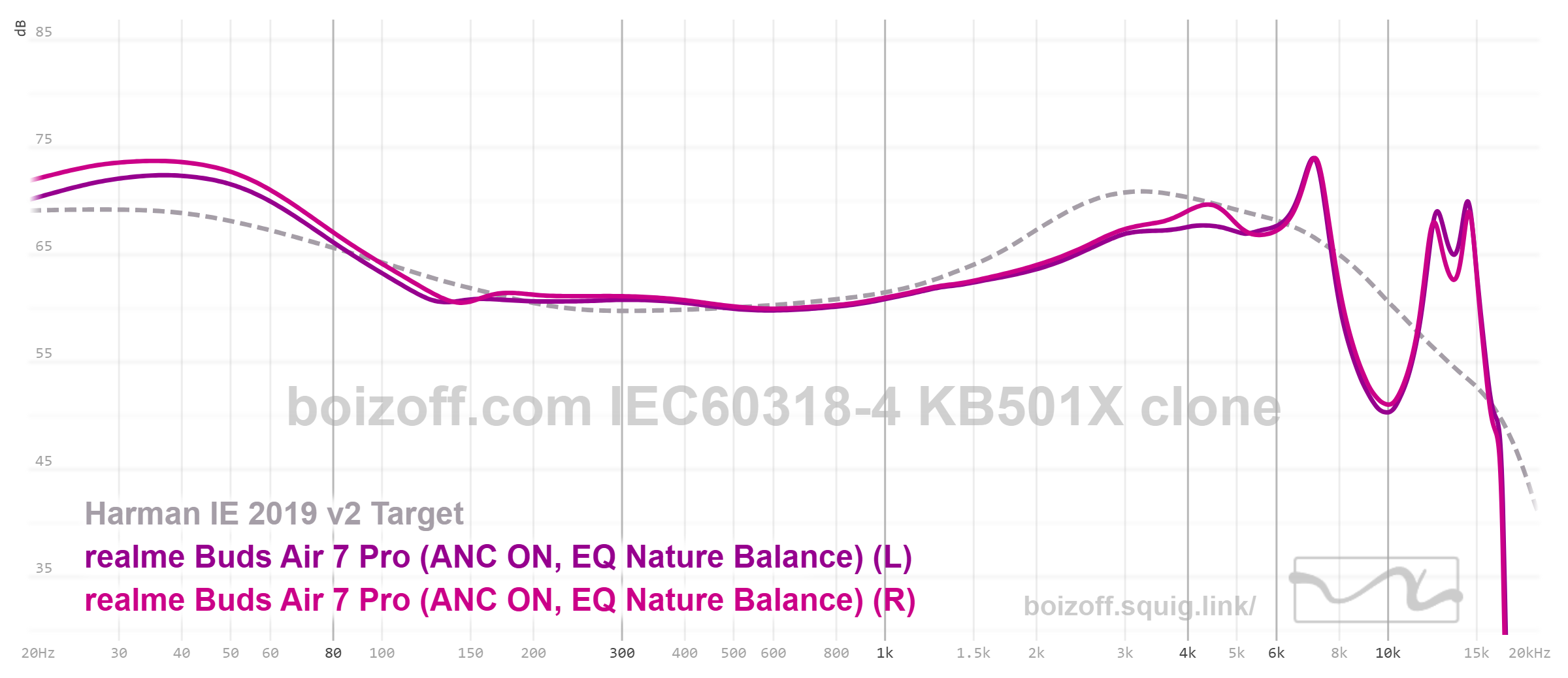
This is an over-subbass, typical for TWS, with an under-middle and an over-top.
With the equalizer, you can achieve the following results:
We get a kind of the Harman curve, just with a giant dip at 9 kHz and ‘sharp’ frequencies after 10 kHz, that is, ‘hissing’.
Usage experience:
These are ordinary, mediocre earphones where the manufacturer failed to ‘put in’ good sound, but instead shuffled in an AI translator and a generator of low-quality nature sounds into the app (sometimes they stop playing spontaneously). The app does not show the case charge and actually refuses to work without signing up.
The active noise reduction is average, the acoustic transparency is nondescript, the microphones are wishy-washy. But, on the other hand, the case can be cleaned without using cotton swabs!
This model is boring and dull.
10. Vivo TWS 4
Price: $30
Specifications and features:
- Firmware version as of the review date: 2.59.1
- Bluetooth version: 5.4
- Codecs: SBC, AAC, LDAC, aptX Adaptive (and aptX Lossless for Vivo TWS 4 Hi-Fi)
- Controls: press and slide
- Equalizer: no
- Connection to two devices: no
- Auto-pause when removing the earphones: yes
- Talk-to-hear: no
- Beginning of a phone conversation: the ANC mode does not change, music playback stops automatically
- Eartips: oval with proprietary mounts
- Extra: nothing defining
- Gray area: none
- Active noise reduction: 3/5
- Transparency mode: 3/5
Sound and measurements:
Frequency response with standard equalizer tuning:
I feel special hatred towards these earphones because their frequency response is very, very difficult to measure properly – the earphones constantly try to turn off ANC as soon as they don’t feel human ears next to them, and this is regardless of the application settings. I had to use a piece of raw chicken meat to make active noise reduction on my measuring rig work.
By default, the earphones are tuned with an approximate eye on the Harman curve, but they have a pretty evenly raised range from 5.5 to 7.5 kHz. Surprisingly, the sound turns out to be really decent where the upper frequencies practically do not hurt the ear, and the earphones sound balanced — at the level of a daredevil and ‘funny’ manner, of course.
There is no equalizer, and other presets significantly deform the frequency balance.
Usage experience:
To clean the case, you will need all-too-common cotton swabs. Yes, again.
Apart from that, with an eye on the price, these earphones are good. There are only very basic functions such as the auto-pause, and there’s no connection to two devices. But the controls are reconfigurable, the microphones are average, but they work, and the ANC is provided, after all. And all this goes almost for a song.
11. Samsung Galaxy Buds3 Pro
Price: $117
Specifications and features:
- Firmware version at the time of writing the review: dated July 29, 2025
- Bluetooth version: 5.4
- Codecs: SBC, AAC, SSC (only with Samsung smartphones)
- Controls: press and slide
- Equalizer: 9-band
- Connection to two devices: no
- Auto-pause when removing the earphones: yes
- Talk-to-hear: yes (intelligent auto-off)
- Beginning of a phone conversation: transparency is turned on (it’s tunable), music playback stops automatically
- Eartips: oval with proprietary mounts
- Extra: voice control over playback, volume, and calls via earphones
- Gray area: it’s difficult to remove eartips
- Active noise reduction: 4.5/5
- Transparency mode: 5/5
Sound and measurements:
Frequency response for ‘balanced’ default tuning:
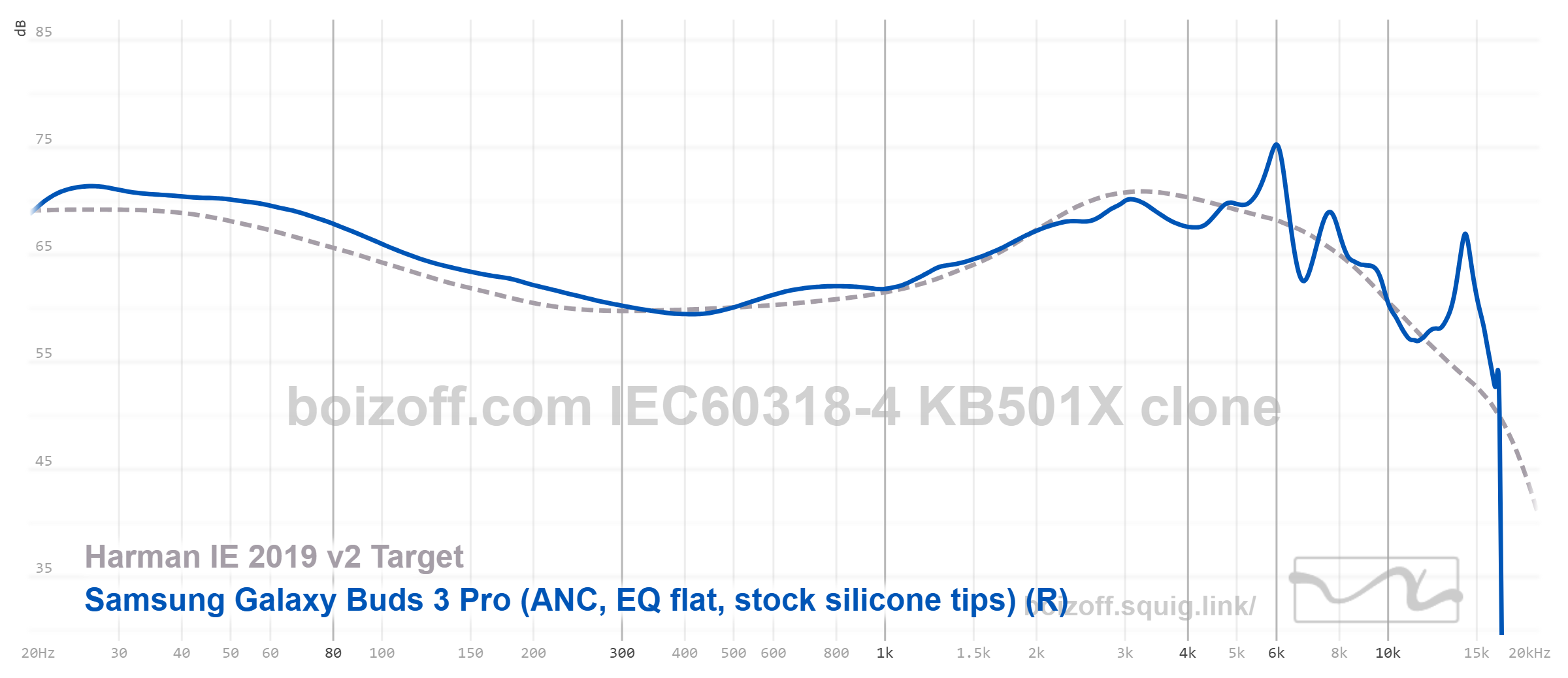
This is Harman-like sound delivery with inflated bass and subbass, as well as sharp peaks at 6 and 14 kHz, which turns into a mumbling and ringing sound.
I came up with this tuning:
With it, the sound is more or less acceptable. This is, so to say, a transitional version between the Harman curve and IEF Preference 2025. The bass sounds much more powerful than you’d expect from this graph, so I’m inclined to believe that my rig is lying a bit. Overall, this is a very decent result for TWS, suitable for listening to musical content in conditions of high street noise.
Usage experience:
There has been a lot of debate on the Internet about the design of triangular (in cross–section) ‘legs’ of Buds 3 Pro whether it’s convenient or not. From my point of view, it’s all the same bollocks to me if they are triangular or round when we talk about the comfort of control, pressing and sliding. But when putting the earphones in the case, this shape creates a certain problem for me: I’ll have to learn how to ‘get’ the earphones into the case very accurately.
The app is all right, everything seems to be at hand (if you have a Samsung phone with OneUI 8, then you don’t need it – all earphone settings are integrated into the system menus). The volume normalizer is implemented, as well as the automatic use of different volume settings for different applications. The charge is displayed as a single digit for both earphones together. How much is left in the case is a mystery. Talk-to-hear is implemented in a weird way: when acoustic transparency is turned on, the music doesn’t stop then, but is muted. But it’s muted to the point where you still can hear it, and it makes it difficult to talk. There’s no setting to stop the music completely. There is balance tuning of the left and right channels, this is cool. It doesn’t grow on every hedge.
The ANC works well, taking into account the shallow fit, but high-frequency sounds are practically not cut off. But I can safely praise the microphones. They are next door to the best ones both in a quiet environment and in conditions of high external noise. Moreover, an unusual approach to voice processing has been chosen: the sounds of the external environment are only slightly muffled, but the voice is not processed by algorithms as much as it’s common now either and remains intelligible. Besides, acoustic transparency is implemented quite well, and, with the help of extra settings, Buds 3 Pro can almost be turned into a hearing aid.
The icing on the cake, though useless, is possible constant glow of diode strips on the earphones’ enclosures, as well as voice control of the earphones (implemented in the earphones’ hardware and independent of a smartphone or voice assistant).
As a result, this is a good instance of serious multifunctional headphones, tainted by a number of strange solutions regarding the shape of the enclosures and sound tuning.
12. Soundcore Liberty 4 Pro
Price: $76
Specifications and features:
- Firmware version at the time of writing the review: earphones – 04.29, case – 01.58
- Bluetooth version: 5.3
- Codecs: SBC, AAC, LDAC
- Controls: press and slide
- Equalizer: 8-band
- Connection to two devices: yes
- Auto-pause when removing the earphones: yes
- Talk-to-hear: yes (timer auto-off, up to 15 seconds)
- Beginning of a phone conversation: the ANC mode does not change, music playback stops automatically
- Eartips: round with more or less standard mounts
- Extra: a black and white micro-screen in the case, the ability to control some earphone settings through the case
- Gray area: ‘Talk-to-hear’ reacts even to a slight cough
- Active noise reduction: 3/5
- Transparency mode: 4/5
Sound and measurements:
Frequency response for a standard sound profile:
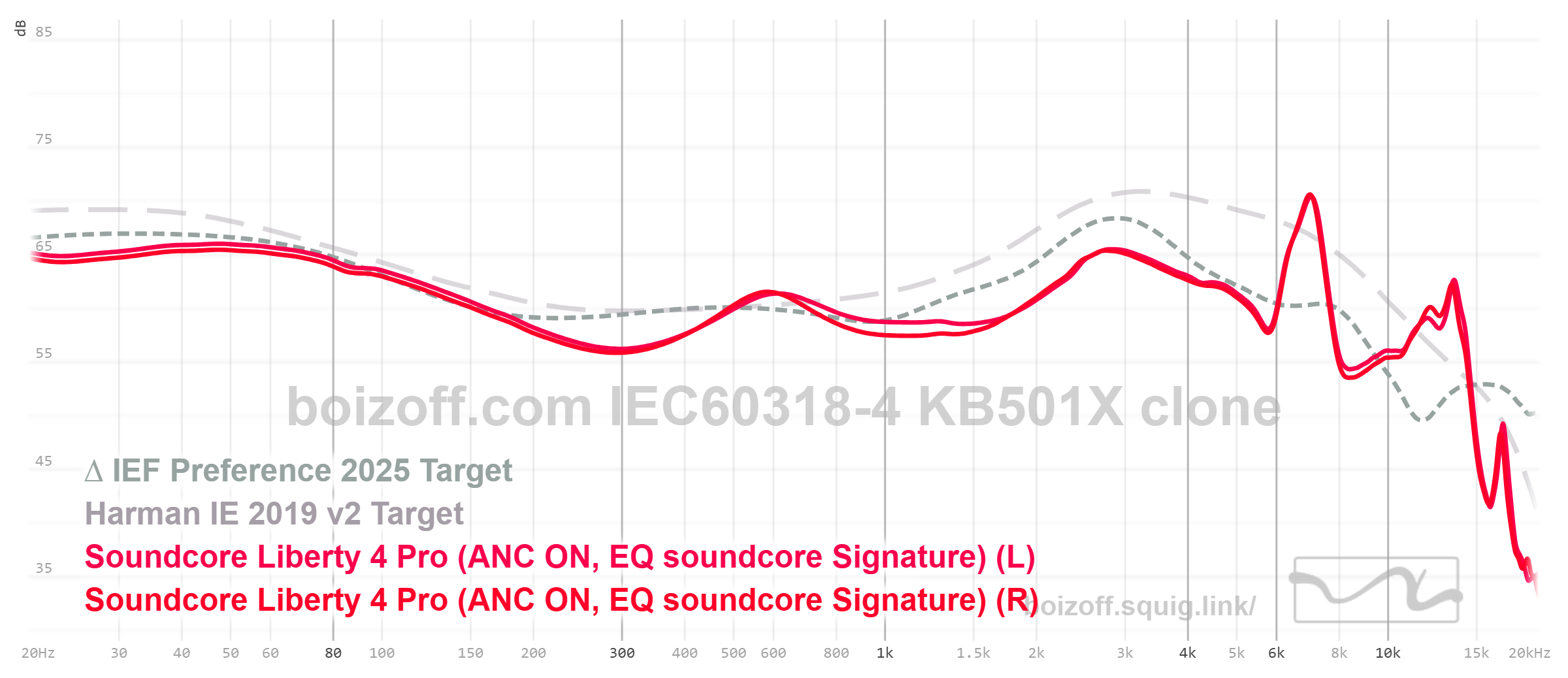
What’s that? Contemporary art? An original take on sound? Is it a matter of taste of a Soundcore creator?
Let’s try to fix things with the equalizer:
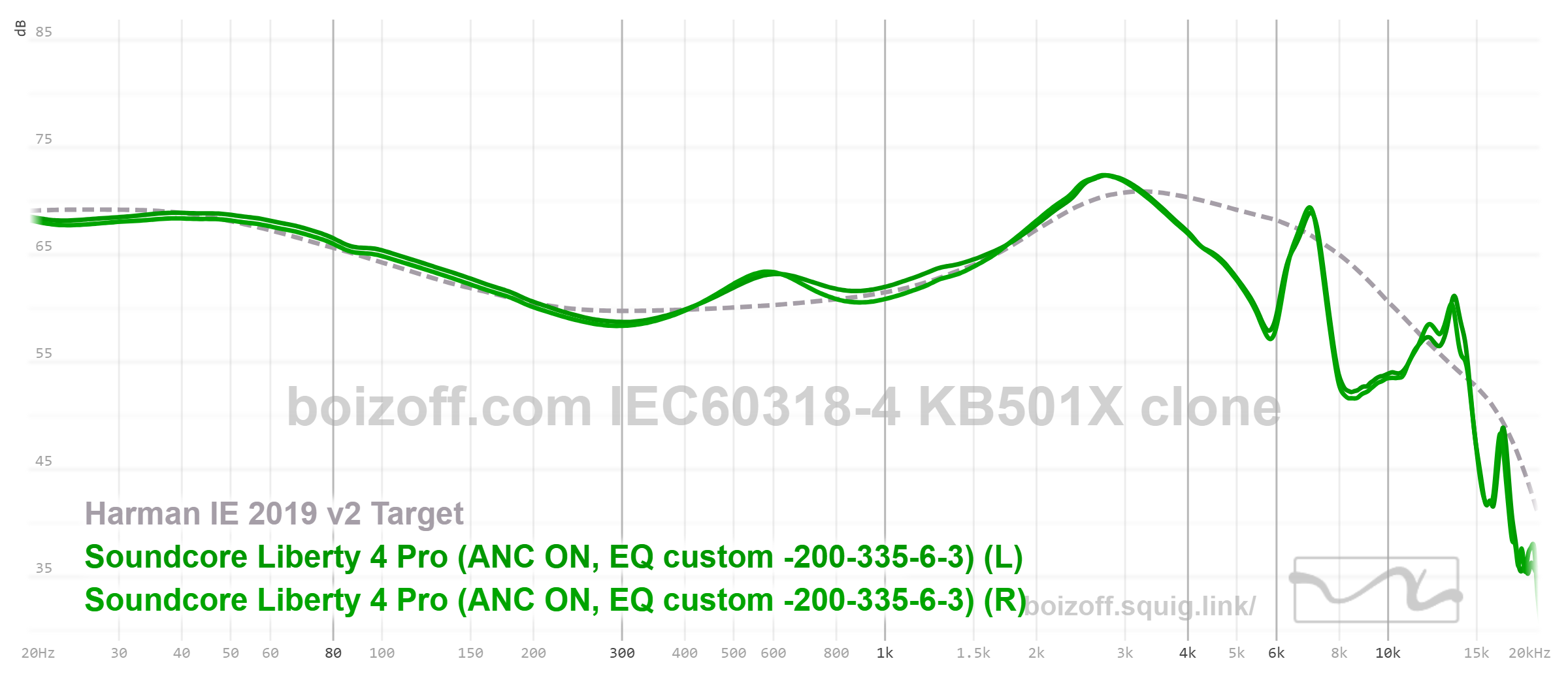
Well… that’s what the ‘still bad’ sound looks like. Liberty 3 Pro after equalization had it radically better.
Usage experience:
I liked the fit of these earphones, as well as how precisely the pressing force is calculated to control them. It’s exactly how it should be. There is also a tweeter in the case to look for it. And, well, the acoustic transparency is good. And the charge of each earphone and of the case is displayed in the app separately.
That’s where the pros come to an end.
‘Talk-to-hear’ works strictly on a timer, active noise reduction is mediocre, and so are the microphones. A tiny screen was inserted into the slide-open case (its lid wobbles a little immediately, from the first minute of use), from which you can control some earphones’ settings, as well as activate camera shooting on your smartphone. Well, of course, we need a case for that! There are no other ways (for example, by voice command)! I’ve outlined everything I have to say about screens in cases in the section below dedicated to JBL earphones.
For this money, with this sound, with smart functions so dull, there’s no way.
13. SONY WF-1000xm5

Price: $180
Specifications and features:
- Firmware version as of the review date: 5.0.2
- Bluetooth version: 5.3
- Codecs: SBC, AAC, LDAC, LC3
- Controls: touch
- Equalizer: 5-band + bass control
- Connection to two devices: yes
- Auto-pause when removing the earphones: yes
- Talk-to-hear: yes
- Beginning of a phone conversation: transparency is turned on, music playback stops automatically
- Eartips: round with more or less standard mounts
- Extra: 360 Reality Audio support
- Gray area: occasional glitches
- Active noise reduction: 5/5
- Transparency mode: 4/5
Sound and measurements:
Here’s the frequency response profile for flat equalizer tuning:
The sound delivery is good for TWS, based on bass and ‘detail’, that is, the 5-8 kHz range. In general, it’s not bad, but I cited the recommended equalizer in this review – it’s better with it, as the middle is slightly ‘pulled out’. It’s not perfect, but it cannot be done perfectly: the first band is already allocated at 400 Hz, and 2.5 and 6.3 kHz sliders are in the upper middle – that’s it. But, at least, there is no dip around 10 kHz, which is typical for almost all other models of such kind.
Usage experience:
I wrote a large review of these earphones, and all the details are already there. Therefore, in short, WF1000xm5 are about the best noise reduction available; they have excellent microphones and decent acoustic transparency; these are the only earphones in which the ‘talk-to-hear’ function is implemented correctly (see the final section of this review).
However, they have an extremely questionable fit, and there is a need to use original foam eartips, which provide half the magic of noise reduction. They have occasional glitches (one earphone is connected, when the second is not, one earphone is in acoustic transparency mode, when the second is not, etc.). The glitches are not critical and are treated by putting the earphones back in the case, but sometimes they are annoying.
These earphones are clearly the leader in noise reduction quality, have excellent microphones and a good sound profile. The question is whether it will be convenient for you to use foam eartips – it depends on how often you put the earphones into and out of your ears, as well as whether the fit will be comfortable for you.
14. JBL Live Beam 3

Price: $141
Specifications and features:
- Firmware version at the time of writing the review: earphones – 4.6.0, case – 4.9.0
- Bluetooth version: 5.3
- Codecs: SBC, AAC, LDAC
- Controls: touch
- Equalizer: 10-band
- Connection to two devices: yes
- Auto-pause when removing the earphones: yes
- Talk-to-hear: yes
- Beginning of a phone conversation: the ANC mode does not change, music playback stops automatically
- Eartips: oval with proprietary mounts
- Extra: settings for the sound of your voice and the other person’s voice during calls, an ability to use one earphone as a spaced microphone
- Gray area: control of either transparency mode or volume
- Active noise reduction: 3.5/5
- Transparency mode: 4.5/5
Sound and measurements:
Frequency response without equalization:

This is the usual TWS sound — thumping and hissing.
Here is the frequency response after an attempt to bring the sound closer to the Harman standard:
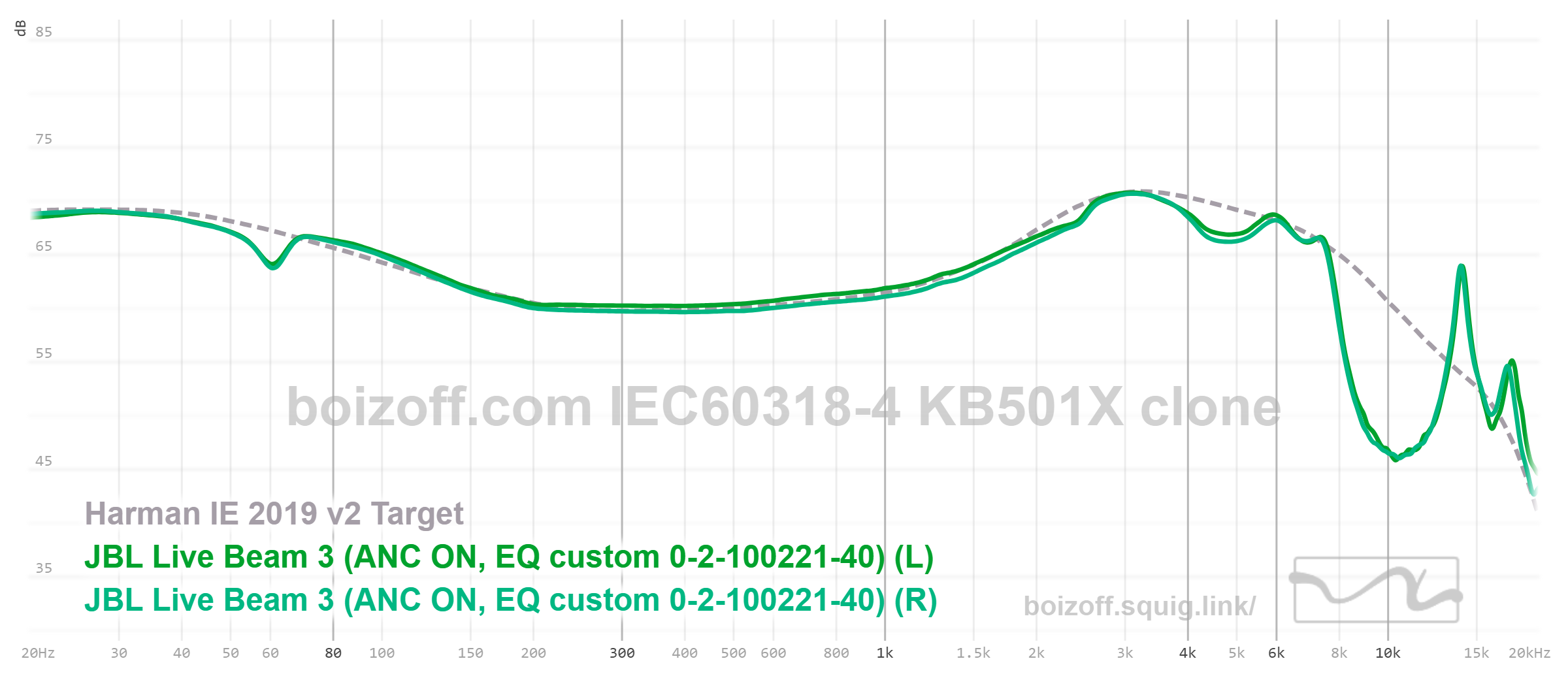
The sound gets much better, but in any equalizer configuration, the earphones continue to mumble, and I failed to fight with it. And, as you can see, this sound signature is not different from the pack of more or less expensive fellows.
Usage experience:
JBL came up with the idea to make a case with a screen. And this is not ‘just a screen’! They turned the case into a separate full-fledged device. This is a touchscreen that displays the earphones’ parameters, it allows for the earphones control, and you can even change the wallpaper on it. There is also a flashlight mode. The flip side of the coin is that the case is frankly large because now it’s not just the earphones that are eating away at the battery.
If you ask me, this idea is fundamentally wrong: earphones were deprived of wires and given smart functions to ennahce the user’s experience and free up their hands, but now they’re imposing another electronic device that duplicates the functionality of the smartphone app. Why? To find work for idle hands again? I’m ready to come up with an excuse for the only function of the case – it can show notifications from a smartphone. Like, you put the case under the monitor or next to your laptop and read notifications on it, not on your phone, to save time… and you don’t have a smartwatch…
I don’t understand who came up with this and how, unless it was a task from marketers to ‘make it not as the next man’.
Bypassing the issue of the screen in the case, the earphones have a lot to praise. The app has a maximum of functions. There is a change in the balance of the left and right channels, acoustic transparency settings that allow you to almost turn the earphones into a hearing aid, and even talk-to-hear is right on cue! By double-tapping the left earphone, the music is muted and acoustic transparency is turned on. Awesome. You can even adjust the sound of both your own voice and the other person’s one during the talk, including the volume normalizer. I’ll also note the shape of the enclosures: they differ from other models in size and shape. They’re rounder than usual. As for my ears, the earphones fit there to a T, and, at the same time, I don’t feel them at all. And the case is convenient to wipe from the inside.
The cons include scanty control settings: it’s impossible to adjust the gestures so as to control both the sound volume and the ANC operating mode. It’s always one thing or the other. There is a mode for using one microphone as a separate earphone, but it was buggy for me, and the voice recording quality itself is really of sorts.
It turns out to be a potentially decentish model, which has a lot of extra stuff, including the screen in the case, but normal microphones, convenient controls and sound are disregarded.
15. Huawei FreeBuds Pro 4

Price: $104
Specifications and features:
- Firmware version as of the review date: 5.0.0.236
- Bluetooth version: 5.2
- Codecs: SBC, AAC, LDAC, L2HC (only with Huawei smartphones)
- Controls: press, tap, and slide
- Equalizer: 10-band
- Connection to two devices: yes
- Auto-pause when removing the earphones: yes
- Talk-to-hear: no
- Beginning of a phone conversation: active noise reduction is automatically turned off, and music playback stops
- Eartips: oval with proprietary mounts
- Extra: foam eartips included
- Gray area: none
- Active noise reduction: 4.5/5
- Transparency mode: 3.5/5
Sound and measurements:
Frequency response of a standard sound profile:
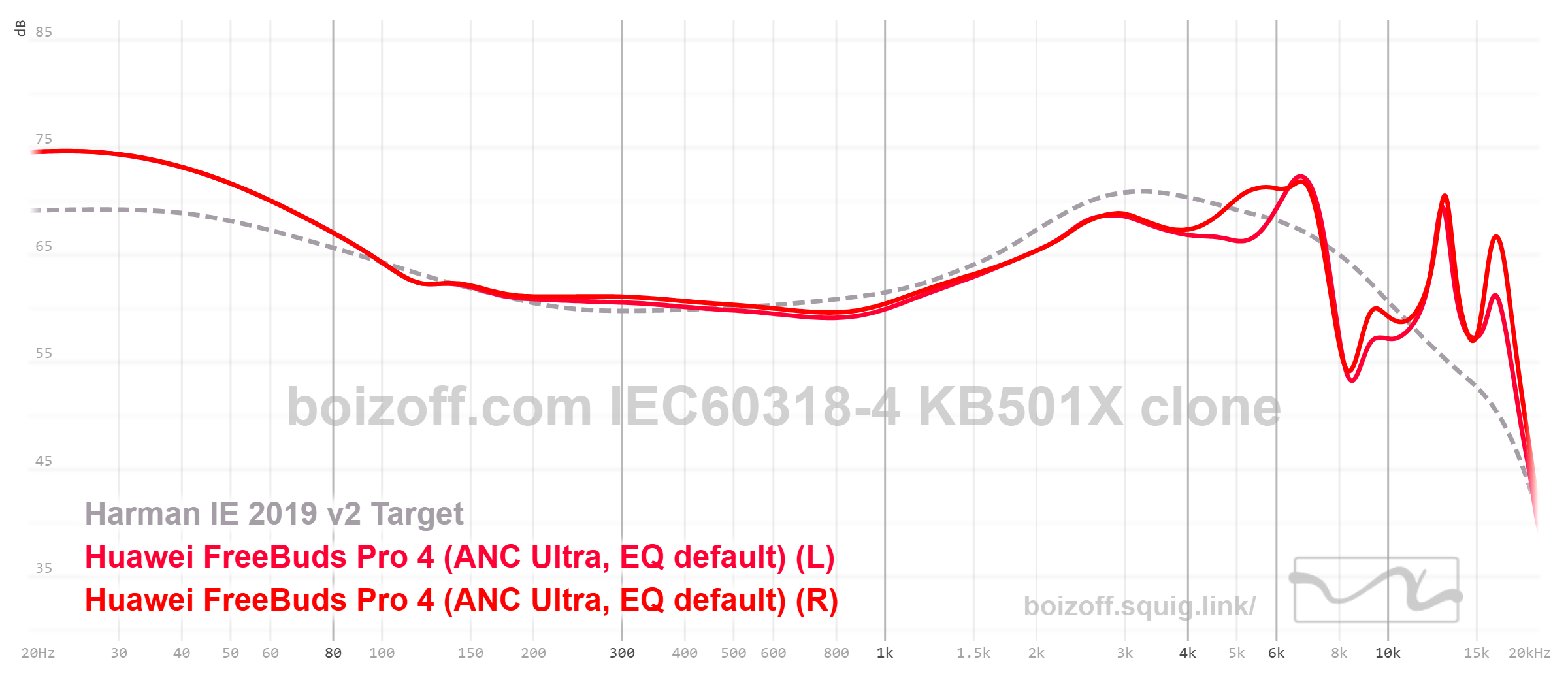
This is a common over-subbass with a peak at the second resonance, but the middle is unexpectedly even. It won’t be possible to remove this peak in a simple way because the nearest points on the 10-band equalizer are 4 and 8 kHz. Therefore, we can try to go off of this frequency in tuning in the belief that it has coincided with the Harman curve (there is no way to get IEF Preference 2025 here).
Here is the tuning:
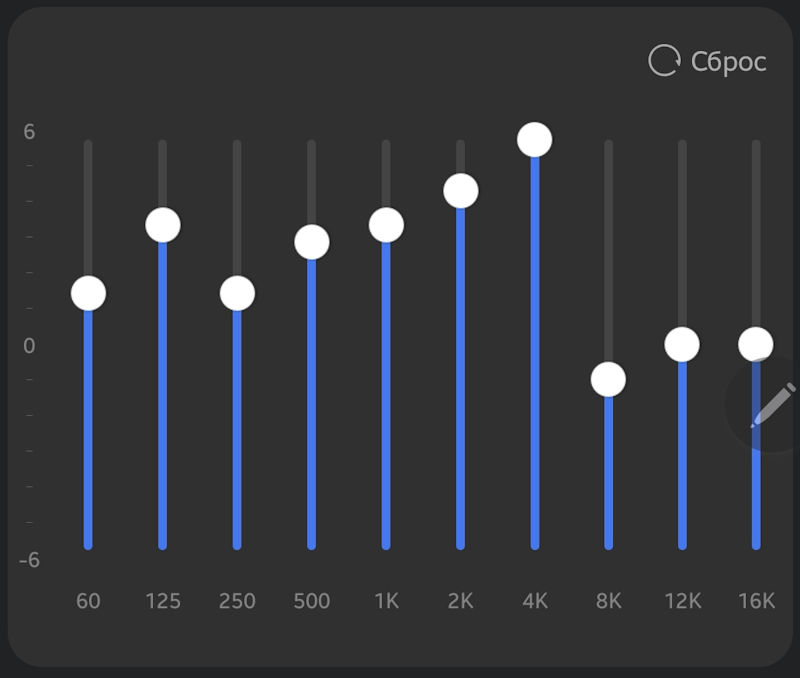
And here is the result after equalization:
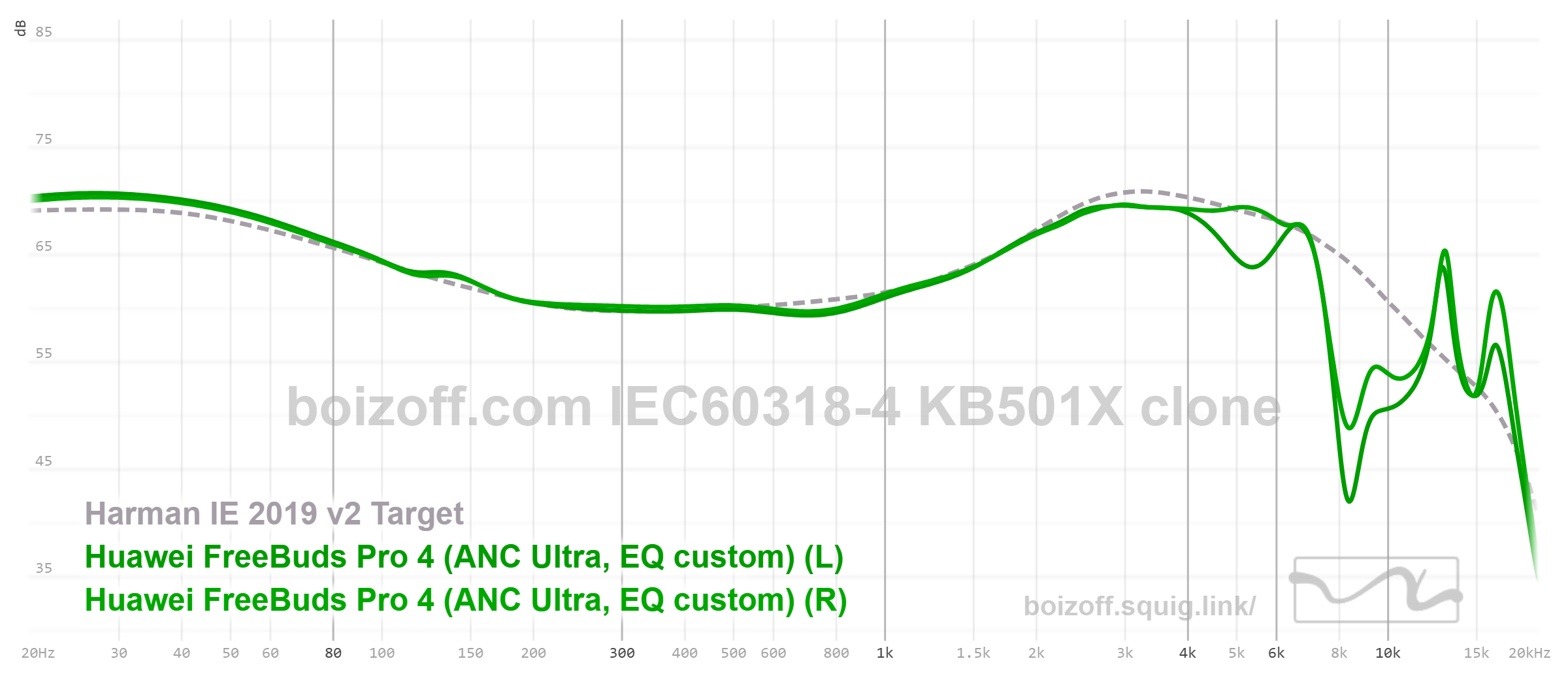
It turns out to be quite a Harman curve, but with a dip at 8 kHz and a sharpish ultra-high-frequency range. For TWS earphones, this is a really great result.
Usage experience:
With a case that opens backwards, I was slow on it for about 10 seconds for the first time. And I make no bones of it! A test for opening the FreeBuds Pro 4 case conducted on 6 friends of mine showed that I’m not a one-off.
Functionally, the earphones are extremely poor. But FreeBuds Pro 4 don’t give us any surprises either. They. Just. Work. The stability of the connection to the source, the response to gestures, everything is as it should be. Active noise reduction is implemented at an above-average level. The microphones are great, and the interlocutor can clearly hear you even in an extremely noisy environment.
In the app, the charge is displayed for the case and both earphones at the same time. I have just one complaint to the point: how do I clean the pits of the case where the ‘buds’ fit in?
16. Moondrop SpaceTravel 2
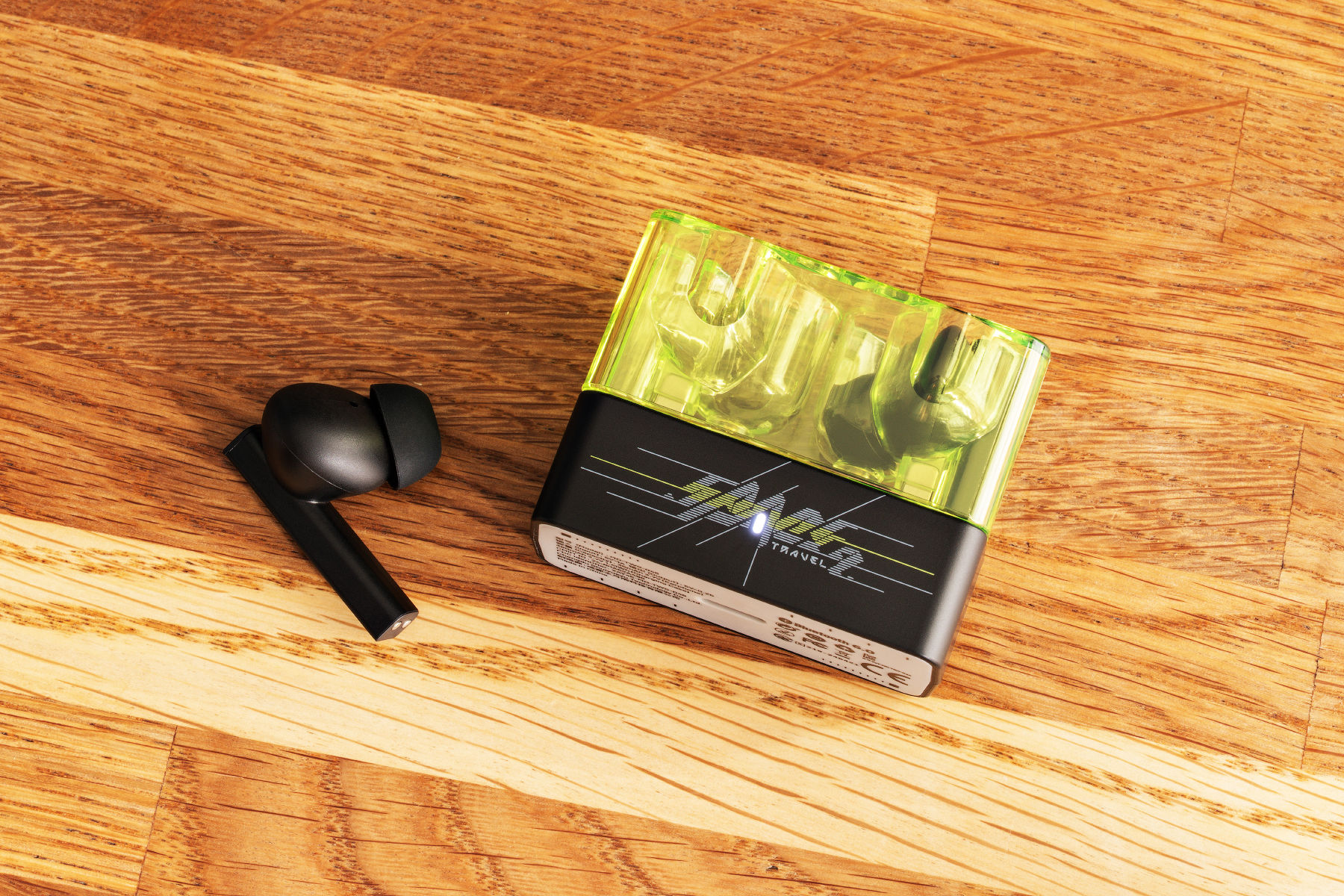
Price: $22
Specifications and features:
- Firmware version as of the review date: 1.3.0
- Bluetooth version: 6.0
- Codecs: SBC, AAC
- Controls: touch
- Equalizer: no (only 3 presets)
- Connection to two devices: no
- Auto-pause when removing the earphones: no
- Talk-to-hear: no
- Beginning of a phone conversation: the ANC mode does not change, music playback stops automatically
- Eartips: oval with proprietary mounts
- Extra: nothing defining
- Gray area: none
- Active noise reduction: 3/5
- Transparency mode: 3/5
Sound and measurements:
Two out of three sound tuning presets are good:

The Reference preset corresponds well to the Δ JM-1 curve (Tilt -10 dB|oct), and the Bass+ preset adds a low-pass filter at +2.6 dB. And this is excellent sound delivery, with some warmth, without sharpness and sibilants, which wins out against most TWS models with a lopsided score.
Just for making the context clear:

Usage experience:
For some 22 dollars, you get TWS earphones with a very, very decent sound and active noise reduction, which is also quite good. It seems that it was not the algorithmic component of ANC that did the trick, but the specific shape of the eartips, which plug ear canals rather tightly.
The app is lame: it takes a long time to connect to the earphones (and sometimes you can’t connect because the app just doesn’t ‘see’ them), a long time to apply settings, and a bunch of options is broken. Even the display of the earphone charge has not been implemented (although a certain percentage of charge of God knows what is displayed in Bluetooth system settings), let alone the case: I can hardly imagine how to remove earphones from it when wearing gloves in autumn and winter.
Microphones are present, they work, but they don’t break any records.
However, I would look at SpaceTravel 2 like this: they work, they play well, they have ANC, and it doesn’t hurt to drop them, scratch them, sweat them, and even lose them, taking into account their price. And in this sense, it’s a very, very cool model. And you’re 99 percent likely to access the app exactly once to select the amount of bass, as shown in the picture above. You won’t have any other reason to use it regularly.
17. Sennheiser Momentum 4 True Wireless

Price: $186
Specifications and features:
- Firmware version as of the review date: 5.19.1
- Bluetooth version: 5.4
- Codecs: SBC, AAC, AptX, AptX Lossless
- Controls: touch
- Equalizer: 5-band
- Connection to two devices: yes
- Auto-pause when removing the earphones: yes
- Talk-to-hear: no
- Beginning of a phone conversation: acoustic transparency is turned on, music playback stops automatically
- Eartips: oval with proprietary mounts
- Extra: nothing defining
- Gray area: none
- Active noise reduction: 2/5
- Transparency mode: 5/5
Sound and measurements:
Default frequency response:
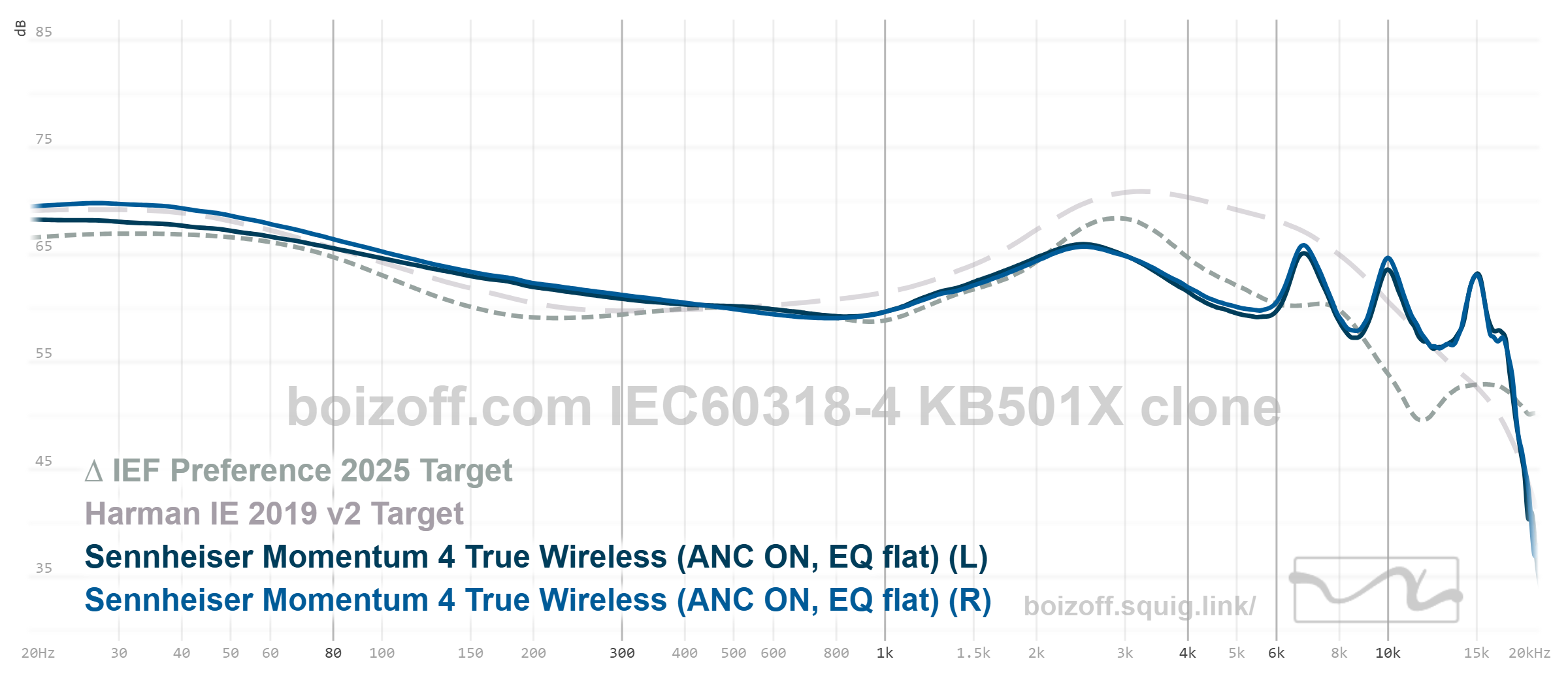
The sound is warm, overly bassy and massive, but it ultimately focuses the listener’s attention on the ultra-high frequency range after 10 kHz. Sharp clicking, whistling, hissing and rasping is constantly heard in all tracks, especially at high volume. And you’ll always want to raise the volume because the volume of the first resonance at 3 kHz is actually lowered.
The situation can be slightly improved by manual adjustment, after which we get the following:
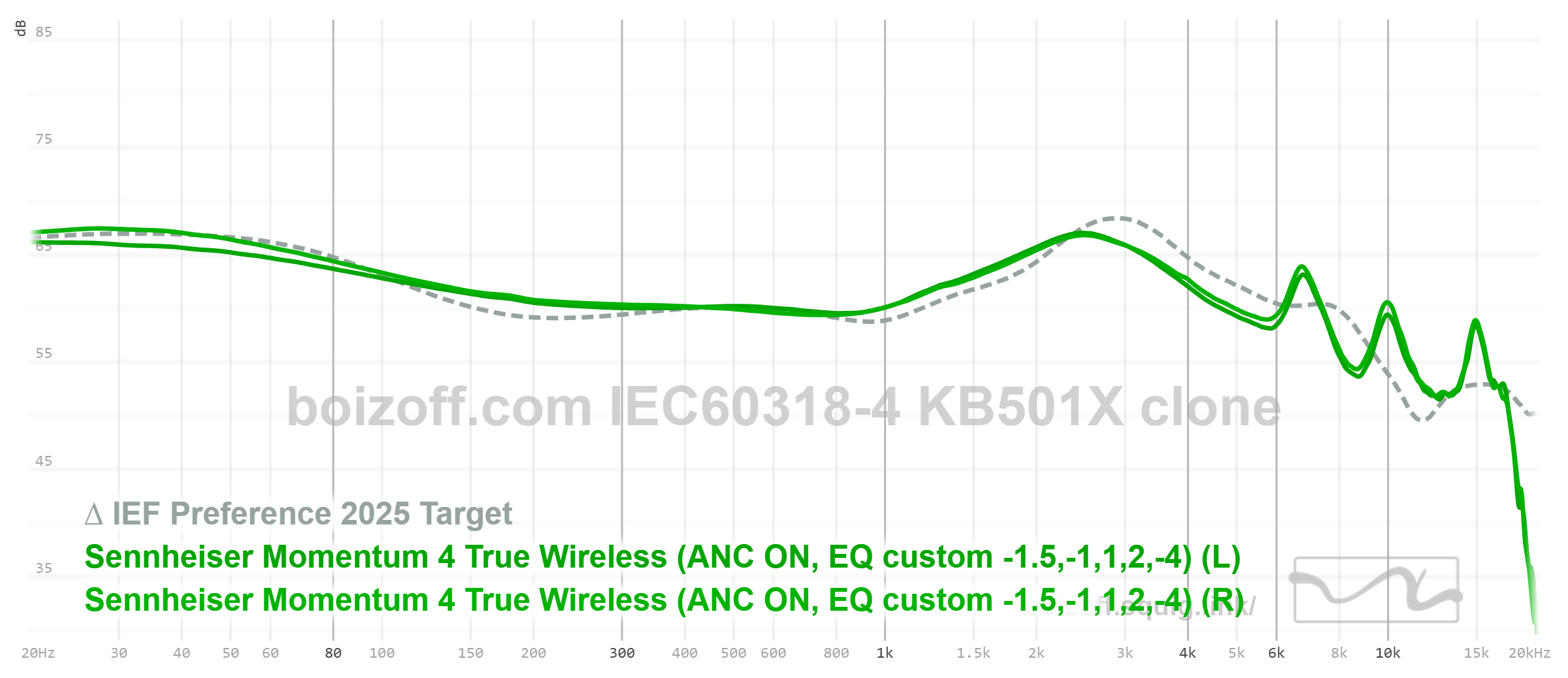
This sound is already much more palatable and closer to IEF Preference 2025. If we compare it with the results of other participants, it’s excellent, although the sharpness does not completely disappear. I was expecting frankly much more from Sennheiser. I’ve recently got acquainted with HD 490 Pro and fell in love with them madly, completely and absolutely — this is how good these headphones are. That is, I’m sure that Sennheiser understands very well what the ‘right’ and ‘wrong’ sounding is all about. What went wrong with the TWS model?
Usage experience:
Sennheiser hasn’t solved its old problem from the time of the first version of Momentum TWS – when you put the earphones in the case, they disconnect from the smartphone, but then reconnect. And no, they are lying flat on the contacts, and the contacts are not muddy. I could actually put an end to this here because this is a ‘blocker’ or ‘critical’, as IT people say. Interestingly, in such a situation, you can’t play music on your smartphone as it stops immediately after pressing the Play button.
But I’ll believe that I have come across a defective specimen, and I’ll go on.
Many things in these TWS are done in a very competent way, for example, the fit. It’s amazing because Sennheiser, just like Bose, thought up ‘two rubber pieces’ – an eartip itself and an additional elastic band that fixes the earphone in the auricle. Due to this, as well as a rather deep fit that’s uncommon for TWS, Momentum 4 fit perfectly in the ears. Or, for example, a single touch of the left earphone is assigned to a combined action ‘playback stop + acoustic transparency on’. This is an excellent implementation for those who don’t like talk-to-hear. The response to control gestures is almost instantaneous, and acoustic transparency is perfectly executed, and even the wind suppression works decently.
The application is a bit confusing and overloaded with strange pictures. The charge is displayed for the case and for both earphones together.
As for the flaws, there is a ton of them, and they’re weird.
I’ve already told about the spontaneous connection when in the case. Sometimes, when you bring your fingers to the earphone, the sound stops for a moment. Other times, when you pull the earphones out of your ears, the music stops as it should, but then it plays for another second and only then finally stops. There is a constant feeling of a lack of manufacturer’s competences in being able to get proper control of the selected hardware platform. As for ANC, it exists, but only in name. In other words, active noise reduction works so poorly that it looks like a conscious decision to make it that way. Say, Moondrop SpaceTravel 2, for example, drown out noises leagues better.
Lastly, the case is upholstered. I have no idea how to clean it.
18. Bose QuietComfort Ultra Earbuds

Price: $223
Specifications and features:
- Firmware version as of the review date: 4.0.20
- Bluetooth version: 5.3
- Codecs: SBC, AAC
- Controls: touch and slide
- Equalizer: 3-band
- Connection to two devices: yes
- Auto-pause when removing the earphones: yes
- Talk-to-hear: no
- Beginning of a phone conversation: the ANC mode does not change, music playback stops automatically
- Eartips: oval with proprietary mounts
- Extra: nothing defining
- Gray area: it’s impossible to reconfigure the control logic
- Active noise reduction: 4.5/5
- Transparency mode: 5/5
Sound and measurements:
Default frequency response:
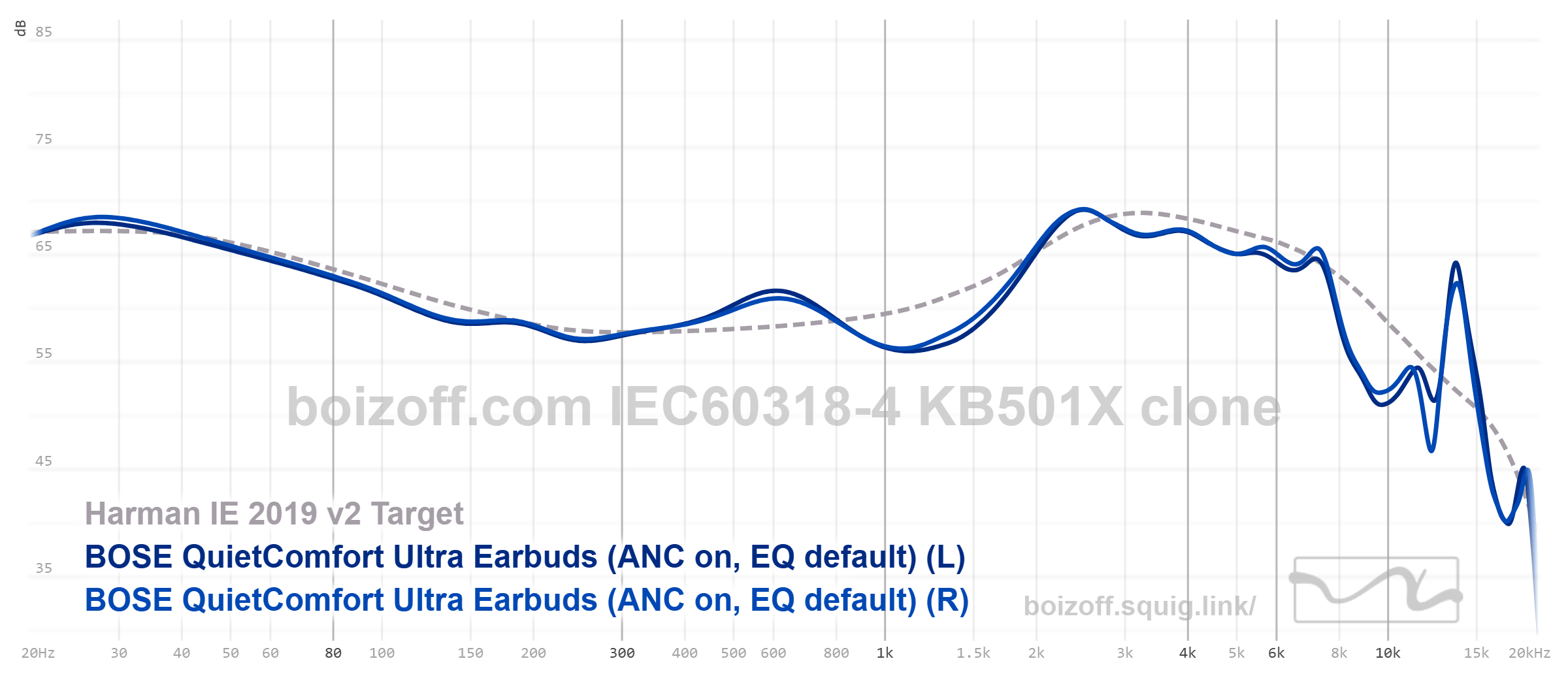
In spite of a strange emphasis at 600 Hz, this tuning sounds just fine. It’s a universal ‘pop’ sound, it’s bassy, massive, and the midrange is not dipped. This is ‘tasty’, universal sound delivery, which has a lot of bottom, middle and top at the same time. If we can compare them with some of the ‘adult’ headphones, it should be Noire X — not in terms of ‘sound quality’, but in terms of the tuning ideology.
Bose really made a great sound. I didn’t expect that.
Usage experience:
The earphones sit in the ears both shallowly and extremely comfortably: additional elastic bands (replaceable, of different sizes) are made to fix the earphones’ enclosures inside the auricles. This also helps to ensure high passive isolation. The acoustic transparency mode is perfectly implemented, and when using it, the environment sounds very realistic. There are no failures when connecting/disconnecting (AAC codec, motherfucker!), the app works stably and even displays the charge of the left and right earphones separately.
But you won’t see the case charge. Besides, you can’t reconfigure the control gestures, there’s just a long touch. The equalizer is 3–band, or ‘bass-middle-top’. Conceptual sound tuning, put it that way.
The only thing that frankly doesn’t please is the microphones: they can’t cope with a noisy street environment near traffic. You’re not just hard to hear — you can’t be heard at all in 90% of cases. And I’ll also note that cotton swabs will be required to clean the case to the fullest, since fingers can no longer fit into its deepest slots.
Please note that the enclosures protrude rather a lot from the auricles due to the design features of the case, so wearing them with a hat can be uncomfortable.
The model gives the impression of a functionally limited, but generally mature product: there is no flexibility in settings and sound because everything has already been done in a right way from the very beginning (except for the microphones).
19. Soundpeats Air5 Pro
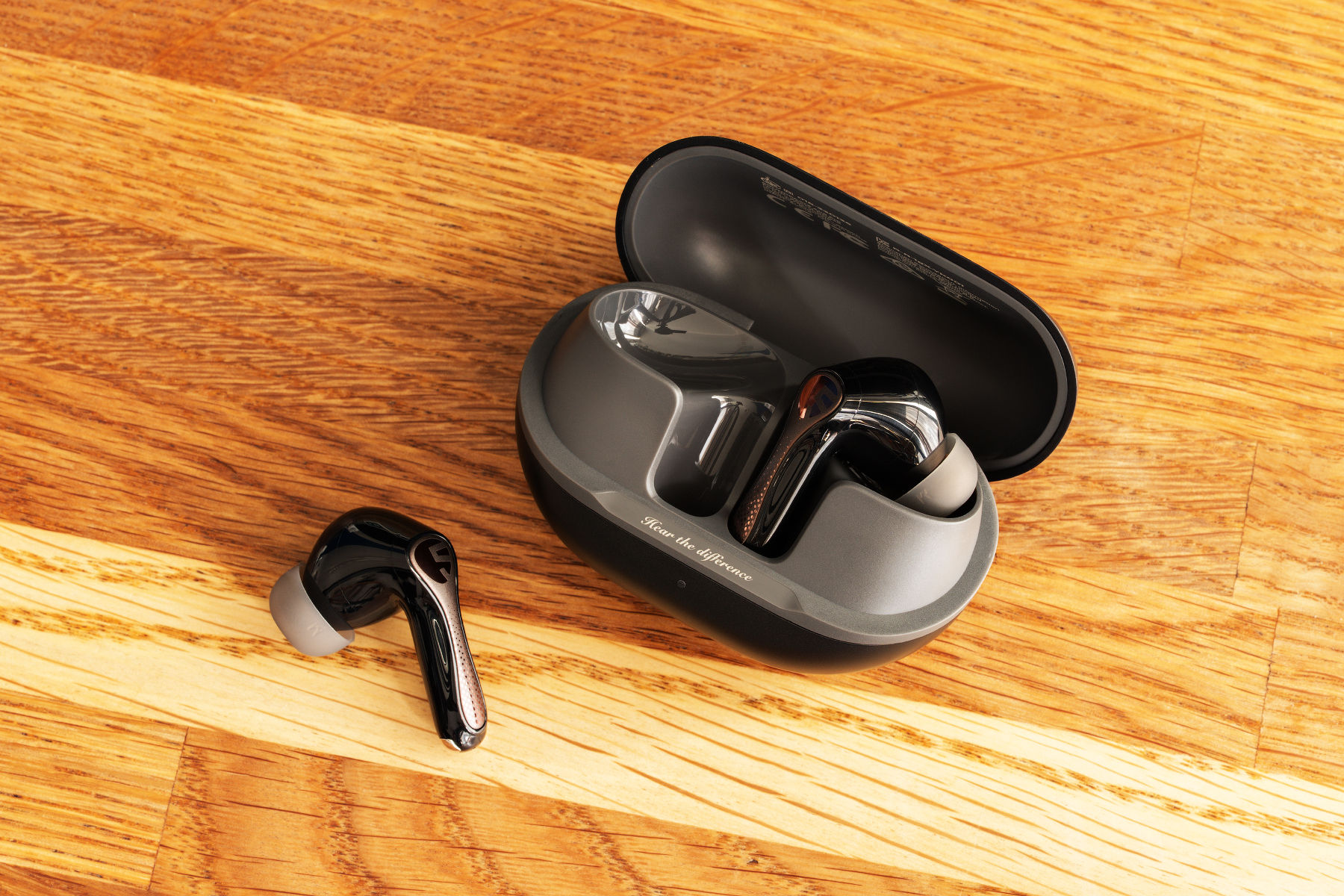
Price: $54
Specifications and features:
- Firmware version as of the review date: 2.2
- Bluetooth version: 5.4
- Codecs: SBC, AAC, LDAC, AptX Adaptive/Lossless, LC3
- Controls: touch
- Equalizer: 10-band
- Connection to two devices: yes
- Auto-pause when removing the earphones: no
- Talk-to-hear: no
- Beginning of a phone conversation: the ANC mode does not change, music playback stops automatically
- Eartips: oval with proprietary mounts
- Extra: touch control can be disabled completely
- Gray area: none
- Active noise reduction: 3/5
- Transparency mode: 3/5
Sound and measurements:
I have a suspicion that Air5 Pro were configured either when in high or in collaboration with Soundcore engineers:
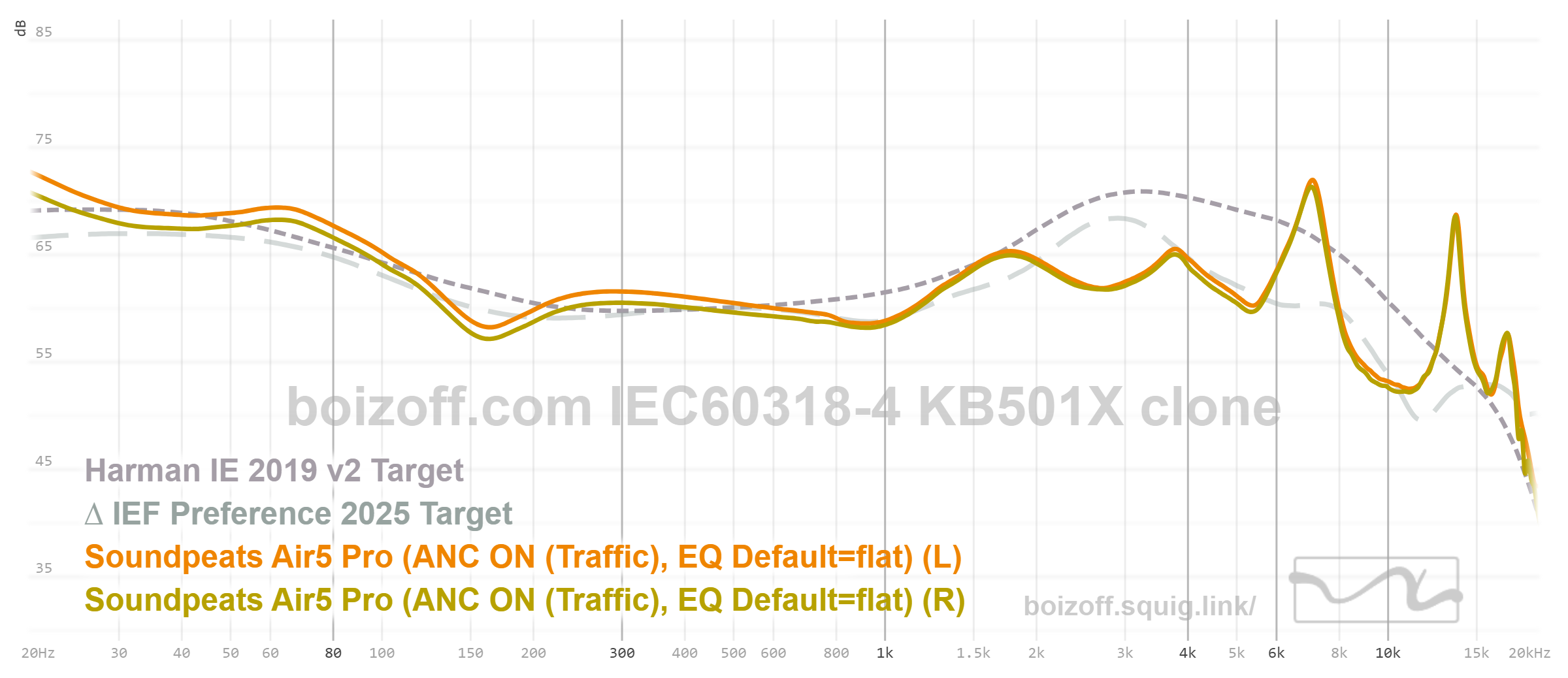
The sound of this model can only be praised for the very fact of the existence of this sound because there is nothing else to praise. The default sound is overloaded with subbass and high frequencies, the middle is not audible, and the equalizer bands are positioned so that no tuning can fix the situation.
Usage experience:
I’m not happy with the app, which reacts very slowly to the application of settings and constantly receives some data from the earphones. I’m not happy with active noise reduction algorithms, which really cut off only the lowest frequencies. I’m not happy that the charge of the earphones and the case is displayed in form of analog stripes instead of numbers.
The microphones are really medicore, as well as ANC.
The earphones are working, and that’s good! There’s nothing else to be happy about with this model.
20. Summary
I would describe the situation on the TWS market in the following words: there are models, for which you can spare money, but there are absolutely no models, for which you want to pay.
Almost all models have the same mistakes.
Sound. Except for Nothing Ear (2024), after equalization, all TWS models are inferior to the cheapest good wired headphones such as KBEAR KB01 ($24) or Moondrop Quarks 2 ($18) in terms of sound. How and on what grounds manufacturers tune sounding of their TWS remains a complete mystery to me, especially bearing in mind that wireless headphones always have a DSP chip, with which you can get any frequency response tuning at all.
It must be a conspiracy! No other way.
Equalizer. Except for Ear (2024), we see good old n-band equalizers. And the problem is not even in their type, but in the fact that they always, really always do not let you regulate the most problematic and most important sections of the frequency response. For example, none of the earphones in this review let you adjust the frequency at 3 kHz (first resonance) or 7 kHz (second resonance). In addition, equalizer bands often work unpredictably, that is, they don’t adjust that very frequency they should, and they do it with an incomprehensible Q factor (the range of frequencies affected).
Okay, dear manufacturers, you don’t want to bother yourself with a parametric equalizer, and it’s valid. Then do it in a simple way, just like what Sean Olive did during his research. There are only 2 knobs for sound tuning:
- the standard curve is a pure Harman one;
- the low frequency knob — 105 Hz, Q factor is 0.71, the point type is ‘low shelf’. You can turn it from -5 to +15 dB. Make at least 5 discrete positions, in 5 dB increments. Although 10 positions in 2 dB increments would be better.
- the high frequency knob — 2,500 Hz, Q factor is 0.4, the point type is ‘high shelf’. You can turn it from -10 dB to +5 dB. Make at least 4 discrete positions, in 5 dB increments, but preferably 6 ones, in 3 dB increments.
And that’s it! Settled! The vast majority of people will find a suitable option for themselves — this is directly proved by the research. And the research is all open, damn it!
Talk-to-hear. It is decently implemented only in Sony WF1000xm5. Let’s look at a simple case: a customer drops in to buy coffee, with earphones in their ears. The customer comes up and says hello, transparency automatically turns on, and the customer tells the drink, pays and leaves/sits down to wait while their coffee is being prepared. When it’s ready, a barista announces that loudly. And the customer picks it up from the counter. A simple conclusion follows from this example: acoustic transparency, being initialized by the talk-to-hear function, should not turn itself off as the customer won’t hear that their coffee is ready. The user must determine on their own whether they still need to hear the external environment. Timers don’t work in this situation, as well as intelligent shutdown. They make this function simply useless: it’s easier to turn off the music with your hands and turn on transparency in order to hear the barista.
This is a purely business analytical task because you can make one extra option and a primitive algorithm in the settings of a regular application in a sprint, no more. However, everyone but Sony cannot solve this task.
Automation during the start of a call. It should be implemented like this: music playback stops, and acoustic transparency turns on, so that the person doesn’t yell while talking on the phone and watches out. There should be at least an option to enable this setting. In this context, 4 out of 14 models mentioned above work right.
As for tangible tips to choose TWS, here they are:
- If sound is your priority, I recommend choosing Nothing Ear (2024) – they are the best in this parameter after applying the equalization mentioned above. If you know how to use the equalizer and squig.link, you can get almost any sound tuning with these earphones. Or, you can sit tight and wait for Nothing Ear (2025). But it’ll be a different price.
- If you are too lazy to bother with any tuning at all, but you want a good sound, excellent ANC and a universal fit, here are Bose QuietComfort Ultra Earbuds. They’re expensive, they have not the best microphones for a noisy environment, but there are no more problems with them at all. An alternative is Xiaomi Buds 5 Pro with a less comfortable fit, light glitches, but better microphones.
- If you grudge the money, but want TWS with a decent sound, choose Moondrop SpaceTravel 2 or VIVO TWS 4. Personally, I like the sound of SpaceTravel 2 more, but TWS 4 fit better into my ears. However, this is highly individual.
- If microphones are critical for you, you have endless work meetings, but you really don’t want to sacrifice all other parameters, choose Samsung Galaxy Buds 3 Pro or Huawei FreeBuds Pro 4.
- Do you need a properly functioning ‘talk-to-hear’ function, the best active noise reduction and good microphones at the same time, and you are ready to tolerate a strange fit or try on eartips if necessary, as well as ignore some glitches? Choose Sony WF-1000xm5.
For now, there is and has never been a truly ultimate TWS model.
That’s it!



